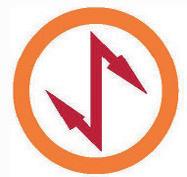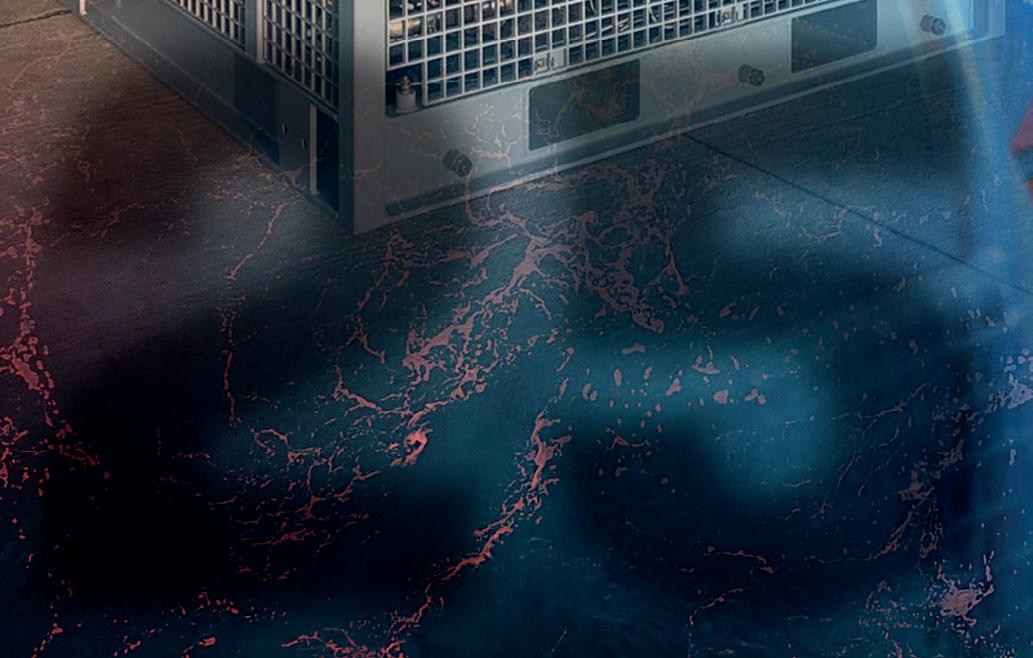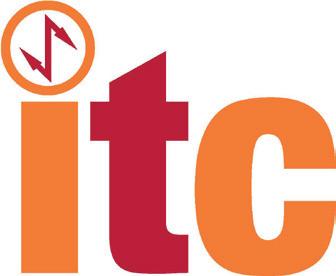







At Wood, our people are what sets us apart, a global community of inquisitive minds. Each one committed to making a difference, to lifting each other up, to showing courage in the face of problems.
As part of Team Wood, you’ll be challenged and inspired to power progress for our people, our business and our planet. Join us as we embark on a quest to unlock solutions to the world’s most critical challenges.
careers.woodplc.com















Welcome to the March edition of ‘OGV Energy Magazine’ where this month we will be exploring the theme of Asset Integrity.

A big thank you to our front cover partner Worley and you can read all about the threephased approach to Asset Management utilised by their ‘Asset Solutions’ team on pages 4-5 inside.
We also have contributions from The Impulse Group, ICR-Group, CAN Group, Flare, PIM Ltd, ROVOP and Rosen .
The rest of this month’s magazine as always provides you with a review of the Energy sector in the North Sea, Europe, Middle East and the US, along with industry analysis and project updates from Westwood Global Energy Group, the EIC and Renewables UK.
Warm regards
Dan Hyland - DirectorAs conventional energy assets continue to age and the overall production declines, the world demand for energy continues to increase and the need for uninterrupted availability of affordable energy sources become increasingly important.
This introduces many challenges to asset owners that need to keep their assets running for an extended period while keeping it safe and facing the ongoing pressure to reduce their associated operational costs. In addition to this, there is generally the willing to reduce manning as far as possible, due to labour shortages and the drive to increase safety, reduce environmental impact and costs.
The Asset Solutions team within Worley is a specialist engineering team helping clients worldwide with these challenges; the team works across all industries and helps clients realize the maximum value from their assets by ensuring mechanical integrity, increasing reliability, whilst reducing operational costs during the whole lifecycle of their assets.
The team has skills in asset integrity management, life extension, maintenance & reliability as well as process optimisation for any type of asset (onshore/offshore, pipeline/topside, upstream/ midstream/downstream), and new energy alternatives (wind, hydrogen etc.).
The Asset Solutions team recognises it is essential for Operators to maximise the return on investment from existing assets and infrastructure. In part, this can be achieved through tailored asset management strategies that considers constraints and challenges imposed within the current energy market as well as identifying opportunities. Worley has found that for our clients are looking at improving their asset management system which involves the balancing
Combining our in-depth technical understanding with our right to left thinking enables us to help clients balance risks and costs, create and sustain long-term value in developing and managing their assets.

 Alessandro La Grotta Director, Asset Solutions
Alessandro La Grotta Director, Asset Solutions

of costs, opportunities, and risks against the desired performance of their assets, to achieve their organisational objectives.
Worley utilizes a holistic ‘full system’ approach to asset integrity management. It is a structured, systematic, stepwise, proven approach to asset and organizational value enhancement specifically designed to help our clients with realizing maximum value from their existing assets.
More specifically the approach that the Asset Solutions team use is a three-phased approach to Asset Management which entails:
1. Project Framing - Stepping back and framing the issues, which may be driven by safety, production, OPEX, resources, left to right thinking.
2. Detailed Evaluation - Carrying out the detailed work to ensure issues are addressed and actions plans are developed. Issues may be related to any one of these areas:
a. Asset Integrity including life extension
b. Reliability and Production Optimisation;
c. Digital Data Management;
3. Implementation - Helping manage change culture and implementation on our clients’ sites and assets.

The core benefits are that all opportunities for asset value enhancement including maximizing production, optimized asset integrity, environmental concerns and organizational efficiency can
be identified and addressed in a fully integrated manner, resulting in a more cost effective and value enhancing way forward in the ‘lower forever’ operating environment.

Three important aspects which the Asset Solutions team find that are important for late life energy asset owners are:
Rationalisation of inspection and maintenance is the key step in successfully achieving OPEX reduction and potentially supporting manning reduction and moving installation to Normally Unattended Installation (NUI). This requires a thorough understanding of current operations coupled with a clear vision of the desired end goal.
The overall quantity of inspection & maintenance activities can be, in some cases, significantly reduced to less than half of the starting point in terms of offshore hours. These changes need to be implemented in a manner that maintains the safety and integrity of the asset. What this means in practice is a detailed assessment of the current operations and identify whole sets of inspection and maintenance routines that can be removed and then incrementally reducing what remains by looking to move to a greater emphasis on risk-based inspection and condition-based maintenance and predictive analytics. As part of the rationalisation activities new technologies surrounding inspection and maintenance will also be investigated identify new technologies and further improve the efficiency of the inspection and maintenance activities.
Life extension studies can support Operators understand the actions that need to be implemented to keep their asset safe and operational forseveral years and can also be used to support a decision where to end (decommission) or extend the asset life as well as support potential expansion and or repurposing projects. There are various assessments which can be carried out in order for Operators to be able to extend the life of their assets, the Worley Asset Solutions team find that our clients ask for the following
• Fitness for Service assessments of their existing infrastructure – these assessments can follow industry guidelines / standards to prepare detailed calculated remaining life values or be fully based on the Operator’s knowledge and inspection results to ascertain whether a pragmatic approach can be made to extend the life of the infrastructure. These assessments provide a robust evaluation to recommend best steps to ensure the continued operation of the asset item.
• Plant condition assessment – A full review of the condition of an asset detailing the open issues, key damage mechanisms acting within the asset and
development of a way forward surrounding maintenance, inspection or in some cases replacement activities.
• Anomaly / Defect Categorisation – Many of our clients have been extremely good at raising and monitoring anomalies, however been challenged in planning the closure of these, this assessment ensures that the key anomalies are still monitored, however the associated inspection / maintenance activities can be planned and implemented efficiently, and that additional work is not undertaken
• Life Extension Studies – Our clients are looking to maximise their investment by extending the life of their assets, the Asset Solutions team will undertake various assessments to come up a structure review of the activities that need to be completed in to extend the life.
• Repurposing Studies – Repurposing existing infrastructure for Hydrogen and CO2 play a key role in the transition to low carbon energy and journey to net zero. Where repurposing is considered the current and likely future condition must be understood considering susceptibility to new threats in addition to system operability.
Our standard 5-step approach for life extension and repurposing is tailored for each asset type (i.e., pipeline, static equipment, etc..) and the project stage/required level of detail. Typically, the 5-step approach includes:
• Step 1 – Data Gathering
• Step 2 – Current Status Assessment
• Step 3 – Future Status (Life Extension/ Repurposing) Assessment
• Step 4 – Optioneering
• Step 5 - Implementation
The ongoing digital transformation has the potential to transform existing assets into “next generation” assets, revolutionizing the way industrial asset Operators run their operations. Technology has enabled realtime monitoring and data analysis which can help increasing efficiency and availability and reducing manning and emissions. All this can ultimately result in reduced OPEX through the elimination of inefficiencies across the entire operation.
We have helped clients with solutions in the asset integrity space along with the areas of predictive maintenance, IoT and real-time data analysis and automation. However, all these opportunities to optimise assets come with their own risks and challenge and during the journey from ideation to implementation.
Worley believe that our clients are looking for digital tools and services that encourage connectivity and can provide visualisation that will assist with the understanding of their integrity management.
The Asset Solutions team have experience in assisting clients with the selection and implementation of asset integrity related software and tools, the team can advise on the capabilities of current market software along and its connectivity to the client’s specific tools and software. As well as working with our clients’ own tools and software.
Asset solutions have their own web-based integrity related visualisation tool called in-site which is based on laser scan data provided by Worley.
Worley have found that most of our clients have many years of laser scan data and 3D models which were created for specific projects or with the aim to fully capture the whole facility. This information provides great value to a large audience and providing access to this information has always been challenging, requiring specific software packages with costly licenses which can only be accessed from powerful desktop PCs.
In-site was developed to provide our customers with a collaborative, accessible platform to allow the visualisation of their facility. The in-site platform is web-based, doesn’t need any software to be downloaded or installed and can be accessed from desktop PCs, laptops and mobile devices at any time. Integrity related information can be added to the overall 3-D scan and can provide our clients with visual knowledge of the integrity threats and anomaly locations. Other capabilities of the in-site platform are:
• Access to an overview map
• Various 2D & 3D display settings
• The ability to slice and crop images and information from the images
• The ability to share information within various other platforms which aids the collaboration between teams which now due to the pandemic sometime are located within different offices
• Annotation on the model
• Accurate measurements
• Tablet / Mobile device accessibility
• VR headset capabilities
• Location of anomalies can be entered within the platform
• Corrosion loop overlay




integrated bypass maintains production during isolation











Dual Leak-Tight Seals
Double Block & Bleed Isolation











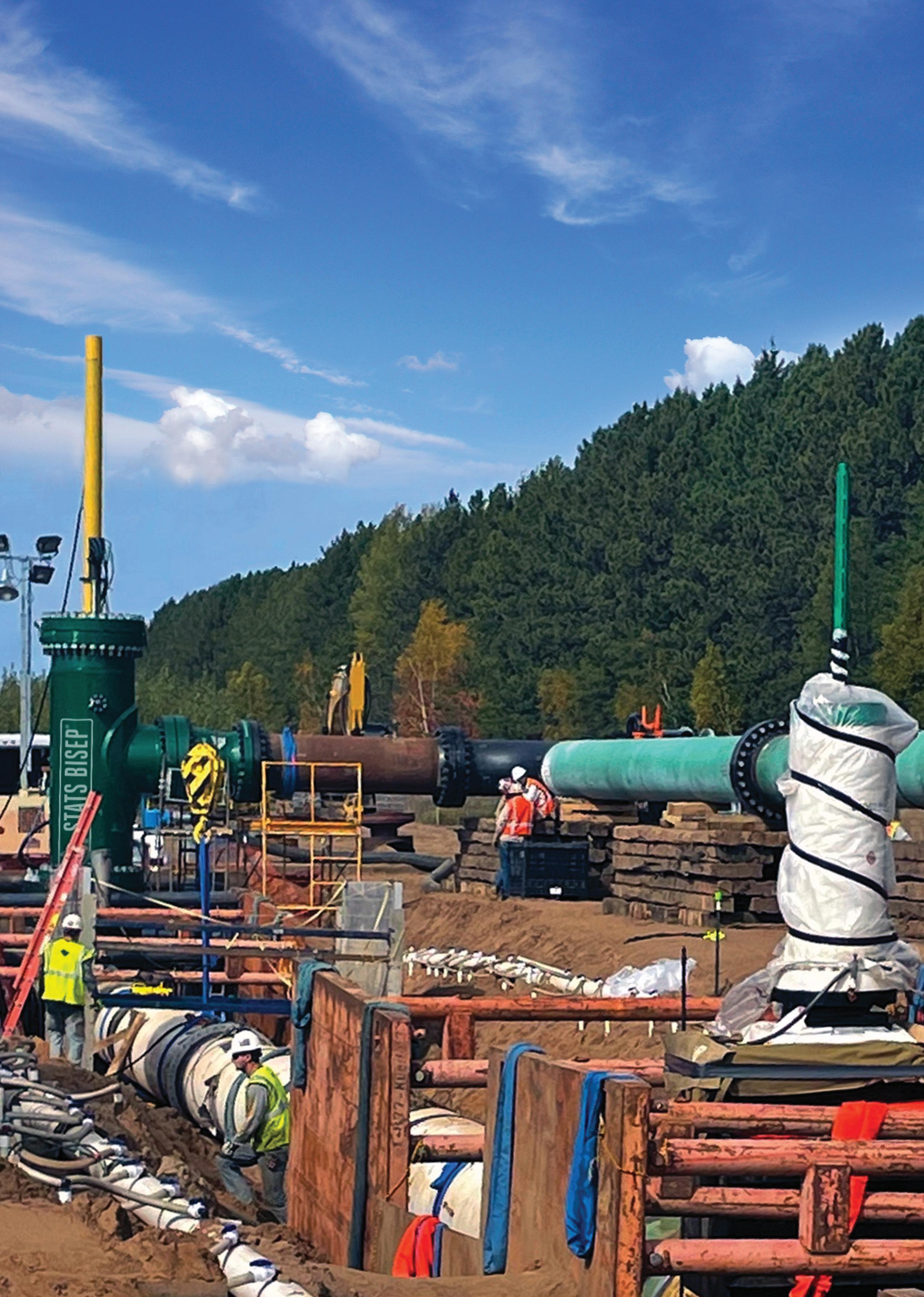
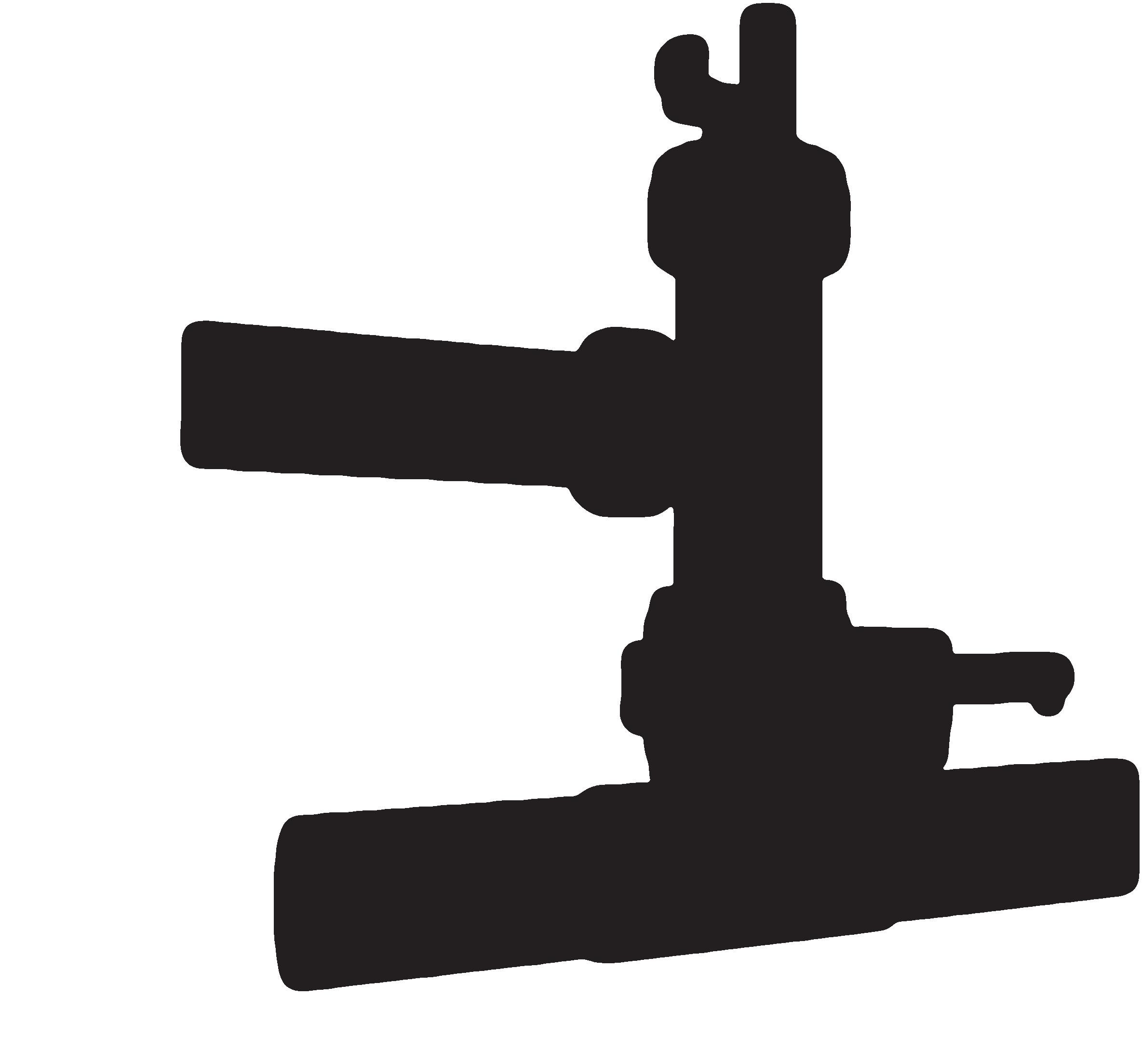




Isolated Pipeline












Monitored Zero-Energy Zone
The BISEP® has an ex tensive track record and provides pioneering double block and bleed isolation while
dual seals provide tested, proven and fully monitored leak-tight isolation, ever y time, any pressure.








































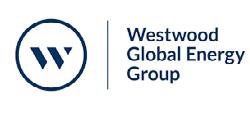












OSSO, the specialist provider of fluid temperature control and separation solutions, has been awarded three individual contracts representing a combined seven-figure sum. The award wins will see OSSO deploy its high-volume mud cooler technology to key geothermal projects within Europe.
Chosen for its extensive drilling knowledge and proven technology, OSSO’s mud cooling offering will provide clients with a unique advantage in reducing downhole temperatures. For one of the contracts, OSSO is providing services for Eavor's groundbreaking Eavor-Europe geothermal project, the world's first commercial implementation of a closed-loop geothermal energy extraction system. This project will generate 8.2 MWe and mitigate approximately 44,000 tCO2e GHG emissions per year, providing clean energy to an estimated 20,000 homes..
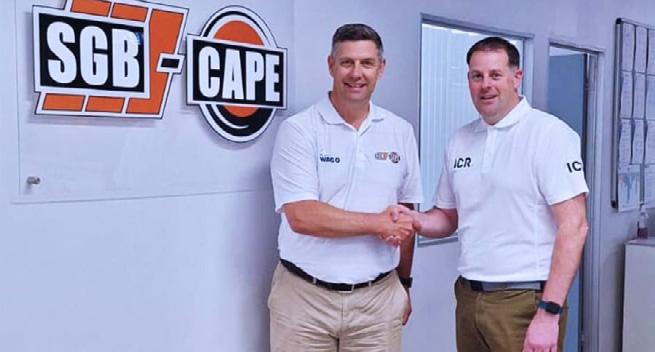
ICR Group expands African network with another strategic partnership
ICR Group, a global leader in maintenance and integrity solutions, has secured another partnership agreement in Africa.
The collaboration with South Africa-based SGBCape, a leading industrial services provider, broadens the scope of ICR's innovative products, including the Technowrap™ composite repair system and Quickflange™ weldless connections.
Scott Byers, Head of Business Development, Africa, at ICR, said: “Welcoming SGB-Cape into the ICR partner network marks another significant step in our mission to deliver cutting-edge integrity solutions worldwide. Their strong presence across the African market is ideal for the rapid introduction of our advanced technologies into new sectors, locations and customers. We are delighted to extend our reach by adding to our African partner network.”
FutureOn expands into West Africa with three-year Azule Energy contract for FieldTwin platform
Angola-based Azule Energy – a standalone integrated energy company combining the local assets of bp and Eni – will use FieldTwin to develop and accelerate four of its projects in the region. This includes the Agogo Integrated West Hub Development Project - widely recognized as one of the major upstream projects being developed in Angola with approximately one billion barrels estimated reserves and the potential to reach peak production of 175,000 barrels a day.
The contract builds on FutureOn’s longstanding relationship with both bp and Eni. Working with global operators, the FieldTwin platform has emerged as a critical technology in the energy sector’s digital toolbox, with a proven track record of enabling collaborative and integrated working, accelerating timelines, achieving cost efficiencies and de-risking activities across the life cycle of assets.

Leading PR, marketing, and design agency, ThinkPR is celebrating the start of the year with several new client wins and receiving award recognition for its work in the third sector.
Marking its 20th year of business, ThinkPR further strengthens its position as an energy-focused marketing agency with client wins including TWMA, Reactive Downhole Tools, Interocean, and Houstonbased PipeSense, in addition to a contract extension with Spirit Energy. The PR specialists have also led a series of Aberdeen-based Emergency Response projects and handled the media launch of the recent Helipets initiative with Scottish Charity, Canine Concern Scotland Trust. The ThinkPR team has expanded to 10 with Amy Cassie and Erin Ingram joining at the end of 2023 as Junior Designer and Account Executive respectively.
ASCO secures major contract with bp for its Trinidad and Tobago operations
Leading material management and logistics provider ASCO has secured a five-year contract with bp Trinidad and Tobago (bpTT). Under the contract, which came into effect at the start of the year, ASCO will provide supply base and pipeyard management services for the Operator across all 16 offshore locations in Trinidad. bpTT has operated in Trinidad and Tobago since 1961, and is the country’s largest hydrocarbon producer, accounting for more than half of the nation’s gas production.
The award cements ASCO's presence in the region, with its in-country headcount set to grow by 30%. The company is also making a significant investment in equipment and infrastructure to deliver this work to the highest international standards.

Global logistics specialist, Petrasco Energy Logistics, has kicked off its 50th anniversary celebrations by exhibiting at Subsea Expo (February 20-22).
Reaching the milestone of 50 years in business during 2024, Petrasco is looking forward to welcoming clients and business contacts to stand 4 as part of the world’s largest annual subsea exhibition and conference.
Organised by the Global Underwater Hub (GUH), Subsea Expo is taking place at P&J Live, Aberdeen –with over 6,000 UK and international visitors expected alongside 150-plus exhibiting companies showcasing their expertise.
The free-to-attend conference provides a platform for companies operating across the underwater industry, including offshore renewables, oil and gas, defence and aquaculture.


Reach Subsea is a leading provider of subsea services. We bring extensive expertise, innovative solutions, and cuttingedge technology to every project.
reachsubsea.no

We are the leader in the design, manufacture and hire of lifting, pulling and deploying solutions in a wide range of applications including shore approach, topside and jacket installation, pipe pull, riser installations and much more. ACE Winches is the trusted partner in the offshore oil and gas, renewable and marine sectors
www.ace-winches.com
MacArtney is a privately owned company founded in 1978; having an extensive track record within the industry as well as strong financials, we strive to work closely with our customers to provide optimal solutions while adhering to the highest standards of service and quality.
www.macartney.com

We are a truly pioneering energy company with a portfolio and ambitions that span the breadth of the energy transition. We’re continuing to break new ground, collaborating and thinking differently.
www.spirit-energy.com/

Accord are a team of experienced and knowledgeable business professionals who have over 50 years of combined industry experience supporting clients across the offshore, energy and maritime sectors.
www.accordbps.com

Specialists in Flexible Pipe Riser and Flowline Integrity Management. TIG are also dedicated to developing a knowledge hub for flexible pipe understanding and research by utilising joint ventures with operators.
theimpulsegroup.com
•
•

www.oegoffshore.com


www.oceaneering.com


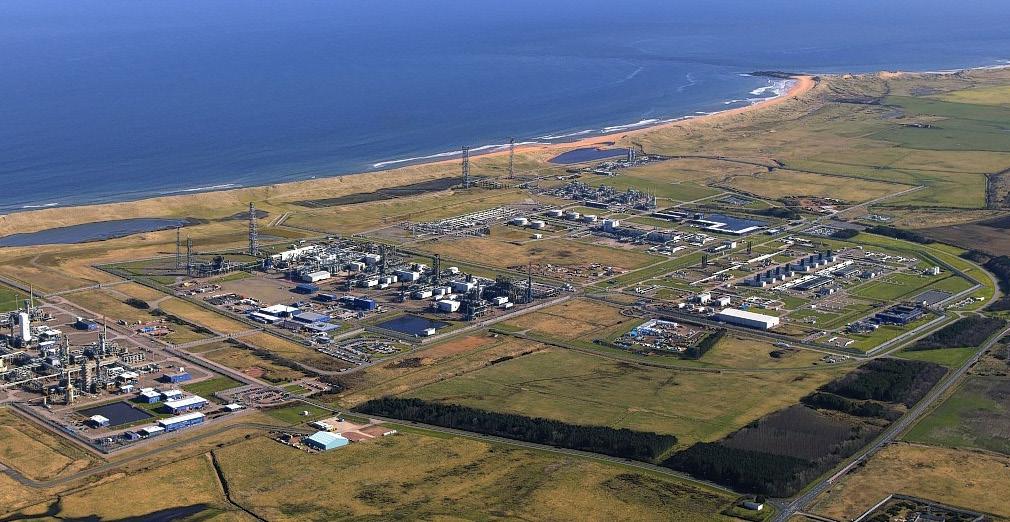
The second tranche of the latest oil and gas licensing round, the industry role in the road to net zero, and field project and development updates featured in the UK North Sea oil and gas sector at the start of 2024.
The North Sea Transition Authority (NSTA) offered at the end of January a total of 24 licences in the second tranche of the 33rd oil and gas licensing round. Shell, bp, Equinor, TotalEnergies, and NEO are among the 17 separate companies which have been offered licences.
The 24 licences follow the 27 licences offered in the first allocation made in October last year. More will follow in the coming months, NSTA said. The 74 blocks and part-blocks offered this time are all in the Central North Sea, Northern North Sea, and West of Shetland areas.
The 33rd Licensing Round opened in October 2022 with more than 900 Blocks being made available. The application window closed in January 2023 with 115 bids coming in from 76 companies, demonstrating the ongoing appetite within industry to explore the UK Continental Shelf, the authority noted.
Internal NSTA analysis show that the average time between licensing and first production is now close to five years, which means that licences awarded now could be producing before the end of the decade.
“These licences have the potential to make a significant contribution to the UK in energy production and economic benefits, and the NSTA will work alongside the licensees to help bring them into production as quickly as possible,” an NSTA spokesperson said.
In its latest report on technology, NSTA found that 1,200 new technologies, including aerial drone and self-driving subsea vehicles, have been reported in the latest survey, a significant upswing from the 1,080 developments recorded the previous year, and 880 in 2021.
David Whitehouse, Offshore Energies UK CEO, commented:
“Meeting more of our needs from homegrown energy produced in the UK means jobs, economic growth, and secure and affordable energy. In a big year for UK and Scottish politics, our message is simple; choose homegrown energy.”

In company news, Murray Auchincloss was appointed in mid-January bp chief executive officer with immediate effect.
Auchincloss, who has been interim CEO since September 2023, will continue as a member of the bp board.
“I fully appreciate just how important the North East is for our energy sector and how important the sector is for Scotland’s
Net Zero technologies have risen from 61 recorded in 2021 to 140 in 2023, and Data and Digital technologies has grown from 190 to 381 in the same time period, according to the survey of 55 operators.
“World-leading technologies, skills and experience boost production and support the energy transition, placing UKCS workers and companies in a great position to secure work and deliver products and services in the UK and in other producing regions around the world,” said Ernie Lamza, NSTA Technology Manager.
Humza Yousaf, First Minister of Scotland, discussed homegrown energy at Offshore Energies UK’s offices in Aberdeen in January.
“I fully appreciate just how important the North East is for our energy sector and how important the sector is for Scotland’s transition to net zero. That is why I value opportunities like this to discuss with industry the detail of their planning to help deliver that transition in a way that is fair and just,” Yousaf said.
“Now, more than ever, our focus must remain on delivery – operating safely and efficiently, executing with discipline, and always focusing on returns,”
Auchincloss said in a statement.
“This is how we will deliver real benefits for our customers and other stakeholders and continue to grow long-term value for bp’s shareholders.”
Shell announced it had taken a final investment decision (FID) on the Victory gas field in the UK North Sea, approximately 47 km north-west of the Shetland Islands.
The development will feature a single subsea well which will be tied back to existing infrastructure of the Greater Laggan Area system, using a new 16 km pipeline.
Shell plans the Victory field to come online in the middle of the decade and at its peak, produce enough gas to heat almost 900,000 homes per year. Most of the field’s recoverable gas is expected to be extracted by the end of the decade.
Once on stream, the field will help to maintain domestically produced gas for Britain’s homes, businesses, and power generation, Shell said.

Because Victory will tie back to existing infrastructure, its operational emissions will be lower than for many current UK North Sea gas fields, according to the supermajor.
National Grid’s Grain LNG and Venture Global announced a binding long-term terminal use agreement enabling the regasification and sale of LNG from all of Venture Global’s LNG terminals in Louisiana, including CP2 LNG, subject to obtaining necessary federal permits. Under the deal, Venture Global will have the ability to access 3 million tonnes per annum of LNG storage and regasification capacity at the Isle of Grain LNG receiving terminal for sixteen years beginning in 2029, equivalent to up to 5 percent of average UK gas demand. In another LNG deal, Centrica Energy and Repsol said in early February they had signed a deal that would improve the UK’s energy security in the coming years. Under the agreement, Centrica will buy 1 million tonnes of LNG shipments between 2025 and 2027. All of these cargoes are expected to be delivered to the Grain LNG import terminal in Kent.
Centrica’s latest agreement follows a 15-year, $8-billion deal with Delfin Midstream in July 2023, a three-year supply agreement with Equinor that will heat 4.5 million UK homes through to 2024, and the reopening and expansion of the Rough gas storage facility in October 2022 and June 2023 respectively.
“Natural Gas is an essential transition fuel in the move to net zero and securing international agreements such as this will be vital if the UK is to reach its ambitious goals,” Centrica group chief executive Chris O’Shea said.
Harbour Energy, the biggest oil and gas producer in the UK North Sea, will look to increase UK drilling activity this year, targeting high return, quick payback opportunities in their operated J-Area, Greater Britannia, and AELE hubs, in addition to the Talbot development. All of these will add to production and support cash flow starting in late 2024, Harbour Energy said in an operations update in January.
Shell UK Ltd, the operator of Licences P2437 and P2252, has confirmed that a rig contract has been signed with Valaris for the drilling of both the Selene exploration well and the Pensacola appraisal well, Shell’s partner Deltic Energy announced. The two wells will be drilled using the heavy duty jackup rig Valaris 123. Selene and Pensacola will be drilled as a two well sequence, with the contract and mobilisation commencing in the June-July 2024 period.
A few days later, Deltic Energy said that it had entered into an agreement to farm out a 25-percent interest in Licence P2437, containing the Selene Prospect, to Dana Petroleum (E&P) Limited. This transaction, in combination with the existing Shell UK carry, results in Deltic retaining a 25-percent non-operated interest in Licence P2437 and having no exposure to 2024 drilling and testing costs up to a cap in excess of current success case well cost estimates provided by the Operator. Completion of the farm-out is conditional on obtaining consent from Shell and standard regulatory consents from the North Sea Transition Authority, Deltic Energy said. The Selene well remains on track to be drilled in the third quarter of 2024.
Optime Subsea has secured a contract with Equinor for the delivery of its Remote Operated Controls System (ROCS) for operator Equinor and its partner Ithaca on the deepwater Rosebank field west of Shetland.
The ROCS system, developed by Optime Subsea, transforms the installation of production tubing in subsea wells by eliminating the need for umbilicals. This results in significantly safer and faster operations while reducing the need for personnel in the red zone on the rig, the company said.
The planned operation for the implementation of ROCS on the Rosebank field is scheduled for June 2025.
bp has awarded Worley a new fiveyear global framework agreement. As part of the contract, Worley will provide engineering, procurement, and construction management (EPCM) services covering bp’s global refinery assets and new energy portfolio including strategic projects in green and blue hydrogen, lower carbon fuels and sustainable aviation fuels.
Serica Energy said in an operations update that its production in 2024 is expected to be higher than in 2023 with guidance between 41,000 boe/d and 48,000 boe/d for the year. This reflects a range of outcomes in a year of significant activity including the speed with which the scheduled drilling and well work deliver incremental production. Serica Energy’s investment plans in 2024 include four wells in the Triton area – Bittern B1z sidetrack, Gannet E GE-05, Guillemot North West EC1, and Evelyn EV-02 – and well work on the Bruce and Keith fields.
Norwegian oil and gas operator DNO ASA said in early February that the company’s wholly-owned subsidiary DNO Exploration UK Limited had entered into an agreement to buy a 25-percent interest in the Arran field on the UK Continental Shelf from ONE-Dyas E&P Limited.
The effective date is set to 1 January 2024 and the transaction is expected to close in the second quarter of 2024, subject to authorities’ approval.
Arran started production in 2021 as a subsea tieback to the Shearwater A platform, both operated by Shell U.K. Limited. Gas from Arran is exported via the Fulmar Gas line on to the St. Fergus Terminal while liquids are exported to Cruden Bay via the Forties Pipeline System.
“Arran fits neatly in our strategy of acquiring bolton producing assets as we develop our significant discoveries in Norway,” said Chris Spencer, DNO’s Managing Director.
“The Company expects financial synergies between Arran and DNO’s existing position in the UK,” Spencer added.



natural gas output
Norway, the UK becoming the first major economy
to halve emissions between 1990 and 2022, and a number of new clean energy
projects featured in Europe’s energy sector at the beginning of the year.
Norway’s natural gas output exceeded forecasts and rose to a record high in December, according to preliminary figures from the Norwegian Offshore Directorate. Norwegian gas production rose to an alltime high of 379 million cubic meters per day (mcm/day), up from November levels and 7.7
percent higher than the directorate’s forecast. Oil production at Western Europe’s biggest oil and gas producer also beat forecasts, by 1.9 percent, and stood at 1.847 million barrels per day (bpd) in December, up from 1.805 million bpd in November.
In January, the Norwegian Ministry of Energy offered 62 new production licences on the Norwegian continental shelf in the Awards in Predefined Areas (APA) 2023 licensing round, up from 47 licences awarded in the previous round.
Of the 62 production licences offered in APA 2023, a total of 29 are located in the North Sea, 25 in the Norwegian Sea, and eight in the Barents Sea.
“To see such great interest in further exploration activity is very encouraging. This is important for both employment and value creation, as well as for facilitating Norway's role as a stable energy supplier to Europe,” said Minister of Energy Terje Aasland.
“Last year, I specifically encouraged companies to explore opportunities in the Barents Sea. This year we are offering more than double the number of production licenses in this region compared to last year's round,” Aasland added.
“Proving more gas resources is important for profitability, by increasing the export capacity from this region.”
Denmark’s largest offshore gas field, Tyra, is on track to resume production in March after years of redevelopment, operator TotalEnergies said at the end of January.
The Tyra field, which was temporarily closed for redevelopment in 2019, remains on schedule for a restart date on 31 March 2024, but “depending on the progress of the project, this may be reached earlier in March,” according to TotalEnergies.
The restart of the field will contribute to the energy security and independence of Denmark and Europe, the French company said.
The UK has become the first major economy to halve its emissions between 1990 and 2022, while also growing its economy by 79 percent, the Department for Energy Security and Net Zero said in early February.
The UK’s emissions reduction of 50 percent compares to a 23-percent reduction in France and no change in the US between 1990 and 2021, the UK government said.
Emissions reductions in the UK have been largely due to cutting emissions from energy generation, through the shift away from using coal to using renewables. In 2012, coal provided almost 40 percent of UK electricity, but later this year, this will be zero, the government added.
Scotland’s First Minister Humza Yousaf said at Scottish Renewables' Offshore Wind Conference in Glasgow in January that the government remains committed to being a partner with the offshore wind industry to “unleash its potential for every single person living in this country”.

“There are moments when certain industries can stand confident that when they look ahead, they will see a future in which they play a pivotal role in securing the wealth and wellbeing of a nation - Scotland’s offshore wind industry is at that moment,” Yousaf said in a speech at the conference.
New statistics released by the Scottish Government on January 26 showed that renewable energy technologies generated the equivalent of 113 percent of Scotland’s overall electricity consumption in 2022 — the highest recorded figures to date and a 26-percent increase year-on-year, Scottish Renewables said.
Responding to the data and the path forward, Claire Mack, Chief Executive of Scottish Renewables, said,
“Maximising capacity in Contracts for Difference Allocation Round 6 this year will be vital to that effort, alongside enabling the critical infrastructure and investment needed to deliver a truly home-grown clean energy system.”
Achieving Ireland’s offshore wind energy target of 37 GW by 2050 could be worth at least 38 billion euros to the Irish economy, according to a new report launched at Wind Energy Ireland’s Annual Conference in Dublin at the end of January.
The report, produced for Green Tech Skillnet and Wind Energy Ireland by BVG Associates, highlighted the need for significant investment in training and skills development to maximise the economic benefit to Ireland from the development of offshore wind.
A final version of the Offshore Renewable Energy Future Framework will be approved by the Government and co-published with the Department of Enterprise, Trade and Employment’s National Industrial Strategy for Offshore Wind in the spring.
The transmission system operator TenneT transmitted around 19.24 terawatt hours (TWh) of wind energy from the German North Sea to land in 2023. In the Netherlands, the figure was 4.17 TWh. In purely mathematical terms, this means that the annual requirements of more than nine million households can be covered by renewable energy (at 3,250 kWh annual consumption per household), TenneT said.
In company news, Thistle Wind Partners (TWP) – a consortium involving DEME, Qair, and Aspiravi – submitted in early February the onshore scoping report for its Ayre Offshore Wind Farm to The Highland Council. This is the first of a series of consenting milestones for TWP’s two ScotWind projects in 2024.
The Ayre project east of Orkney will be a 1 GW floating wind farm, contributing to the UK and Scottish Government’s targets for accelerating floating wind capacity.

“This report identifies, in granular detail, the skills we need over the next two decades to transform our workforce to build not just Ireland’s offshore wind energy future but to compete internationally,” said Noel Cunniffe, CEO of Wind Energy Ireland.
At the end of January, the Irish government also opened a consultation on the Offshore Renewable Energy (ORE) Future Framework Policy Statement.
The Future Framework is the long-term model and vision for offshore renewable energy in Ireland, setting out the pathway Ireland will take to deliver 20 GW of offshore wind by 2040 and at least 37 GW by 2050.
“Last year was a landmark year for offshore energy in Ireland with over 3GW of capacity, which will be delivered by 2030, procured from our first offshore wind auction,” said Minister for the Environment, Climate and Communications, Eamon Ryan.
Shell has joined the Renewables for Subsea Power (RSP) collaborative project, which is currently powering subsea equipment off the coast of Orkney through a combination of wave power and subsea energy storage, Aberdeen intelligent energy management specialists Verlume said in early February.
The £2 million demonstrator initiative, currently nearing 12 months in the water, has connected the Blue X wave energy converter –built by Edinburgh company Mocean Energy – with a Halo underwater battery storage system developed by Verlume.
Copenhagen Infrastructure Partners (CIP) has launched Copenhagen Energy Islands, a new development company dedicated to developing energy islands globally with backing from Nordic, European, and North American investors. The new company is currently developing a portfolio of around 10 energy island projects around the North Sea, the Baltic Sea, and in South-East Asia
CIP sees energy islands as a key tool in solving the challenge of integrating largescale offshore wind energy into the global energy systems and “realizing the ambitious offshore wind targets across the globe,” said Jakob Baruël Poulsen, Managing Partner and founder of CIP.
Green and renewable hydrogen producer and supplier Lhyfe and European renewable energy developer Source Galileo announced in January their joint agreement to develop commercialscale green and renewable hydrogen production units in the UK and Ireland.
“Initially, the companies will focus on using electricity from onshore renewable sources. However, in the longer term, they could harness the enormous offshore wind potential in the UK and Ireland, which would help overcome electricity grid constraints,” Lhyfe said in a statement.
Equinor’s first commercial battery storage asset, the 25 MW/50 MWh Blandford Road asset in Dorset in the UK, has started operations. Comprising around 150 lithiumion battery units, Blandford Road can store enough electricity to power 75,000 UK homes for two hours.
“This is a significant milestone for our ambition to deliver flexible power and maintain security of supply in the UK,” said Alex Grant, UK Country Manager at Equinor.
TotalEnergies has signed a new agreement with European Energy to develop offshore wind projects in Denmark, Finland, and Sweden, as part of its integrated development in electricity. TotalEnergies is buying offshore wind development assets in Denmark and will collaborate with European Energy to develop and operate new large scale offshore wind projects in Sweden and Finland through a joint venture. The partners also intend to bid for the upcoming offshore wind tenders in Denmark. In Germany, TotalEnergies has signed an agreement to buy from its three founders the entire share capital of Kyon Energy, which is one of the leading developers of battery storage systems in the country. Since its creation in 2021, Kyon Energy has developed 770 MW of projects with very competitive connection costs of which 120 MW are already in operation, 350 MW are under construction, and 300 MW are ready to build. In addition, Kyon Energy’s portfolio includes a 2 GW pipeline of advanced-stage projects, TotalEnergies said.
Also in Germany, Octopus Energy’s generation arm has made its first two investments in the German solar market by acquiring the 122 MW Schiebsdorf solar farm in Brandenburg and the 20.8 MW Hartungshof solar farm near Saarbrücken.
The Schiebsdorf solar farm site is currently under construction, targeting completion later this year, while the Hartungshof site in the vicinity of Saarbrücken in Saarland has been operational since March 2023, Octopus Energy said.

According to Dittmar, for the best quality resource, there are now more buyers than sellers, which is pushing up prices.


A record-breaking quarter for US upstream mergers and acquisitions and the Biden Administration’s decision to pause new permits for LNG export projects were the highlights of the US oil and gas industry at the beginning of the year.SPONSORED BY

The US upstream oil and gas industry saw a record-setting $144 billion in mergers and acquisitions (M&A) deals in the fourth quarter of 2023—the largest in any quarter that Enverus Intelligence Research (EIR) has tracked.
That pushed full-year 2023 upstream deals value to more than $190 billion, which also set an annual record for M&A activity in terms of value.
The two historic deals of $60 billion and more from ExxonMobil and Chevron drove the surge in transaction value in the final quarter and full-year 2023. Exxon announced a deal to buy Pioneer Natural Resources in a $65 billion transaction, the third-largest upstream deal ever by enterprise value, and Chevron purchased Hess for $60 billion in the fourthlargest ever such deal, EIR’s analysis showed at the end of January.
“Oil and gas is undergoing a historic consolidation wave comparable to what occurred in the late 1990s and early 2000s giving rise to the modern supermajors,” said Andrew Dittmar, senior vice president at Enverus.
“After a decade of lowered investment in exploration and with the major U.S. shale plays largely defined, M&A has become the preferred tool to replace declining reserves and secure longevity in these companies’ profitable upstream businesses.”
Assets
From flare tip to the jacket, Digitising Reality can create a digital twin of your offshore asset so you can efficiently manage your resources effectively.
During Q4 and the full year, the Permian Basin drove most of the M&A activity in the US shale patch, as buyers were willing to pay up for future drilling inventory, Dittmar added.
“While the buyer interest is still there, we are unlikely to see an encore in 2024 because the available list of attractive takeout targets has grown short,” the Enverus senior vice president said.
Going forward, companies may be looking to buy more gas-weighted assets, according to Dittmar.
However, the US gas market players have been recently shaken by the Biden Administration’s decision to temporarily pause pending decisions on LNG exports to non-FTA countries until the Department of Energy can update the underlying analyses for authorisations.
During the temporary pause, DOE will carry out a new updated review on the impact of such projects on health and communities.
“The current economic and environmental analyses DOE uses to underpin its LNG export authorizations are roughly five years old and no longer adequately account for considerations like potential energy cost increases for American consumers and manufacturers beyond current authorizations
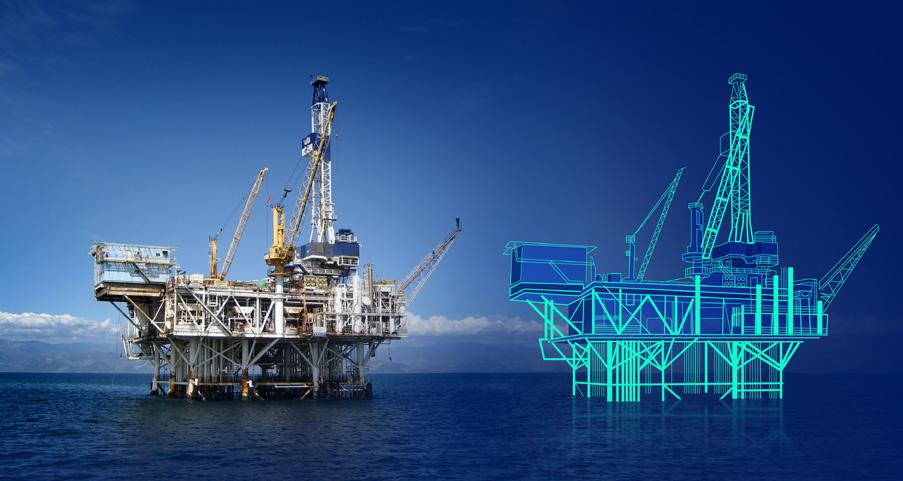
or the latest assessment of the impact of greenhouse gas emissions,” the White House said.
The pause in approvals, which is subject to exceptions for unanticipated and immediate national security emergencies, will provide the time to integrate these critical considerations, the Administration said.

It also noted that the announcement would not impact US ability to continue supplying LNG to its allies in the near term as “Through existing LNG production and export infrastructure, the U.S. has – and will continue – to deliver for our allies.”
Industry groups and associations, however, criticized the Administration’s decision to halt the approval of pending permits, saying it is a loss for American jobs and allies and “a win for Russia.”
The American Petroleum Institute (API), the American Exploration and Production Council (AXPC), Center for LNG (CLNG), Independent Petroleum Association of America (IPAA), LNG Allies, and dozens of other industry groups from across the LNG value chain wrote a letter to US Energy Secretary Jennifer Granholm and senior administration officials. In the letter, the industry group said that restricting LNG exports would threaten US national security, US jobs, and climate goals.
“Moving forward with a pause on new U.S. LNG export approvals would only bolster Russian influence and undercut President Biden’s own commitment to supply our allies with reliable energy, undermining American credibility and threatening American jobs,” the associations said.
API President and CEO Mike Sommers commented that “There is no review needed to understand the clear benefits of U.S. LNG for stabilizing global energy markets, supporting thousands of American jobs and reducing emissions around the world by transitioning countries toward cleaner fuels.”
Sommers added, “This is nothing more than a broken promise to U.S. allies, and it’s time for the administration to stop playing politics with global energy security.”
Texas Railroad Commissioner Wayne Christian noted that “Texas natural gas is saving the free world, and President Biden wants to end it.
“His administration’s pause on new liquified natural gas export (LNG) plants may recklessly endanger European lives, many of whom are facing a harsh winter with less access to lifesaving energy,” Christian added in a statement issued by the Texas Railroad Commission, the oil and gas regulator in the state.
“This move by the Biden Administration is just the latest in a long line of actions to dismantle American oil and gas production and does NOT eliminate emissions. It simply exports them to dirtier and more hostile producers overseas,” Christian said.
Texas Oil & Gas Association (TXOGA) also criticized the Administration, with President Todd Staples saying that “This decision is a major mistake that puts American jobs and allies at risk and undermines the global progress made possible through increased use of natural gas.”
“It directly emboldens and strengthens America’s adversaries while hurting America.”
Staples noted that the halting of LNG export permit approvals risks nearly $200 billion of investments over the next five years and an annual average of 9,000 direct jobs that TXOGA estimate would be put to work in the American economy.
“Even just the pause in the permitting process is causing major disruptions and costing our nation billions of dollars in economic activity.” Groups including Energy Workforce & Technology Council (EWTC), the Independent Petroleum Association of America (IPAA), US Oil and Gas Association (USOGA), National Ocean Industries Association (NOIA), Texas Alliance of Energy Producers, Western Energy Alliance, and Gulf Energy Alliance, urged Congress on 1 February to take immediate legislative action to counter the Biden Administrations’ decision to halt LNG permits.
The legislation, “Unlocking our Domestic LNG Potential Act,” was introduced by U.S. Congressman August Pfluger and seeks to place the Federal Energy Regulatory Commission in charge of all LNG export permitting in the United States.
“It is vital that Congress send an immediate message to our allies, and enemies, abroad that U.S LNG will continue to flow uninterrupted for many years to come,” the trade associations wrote.
According to Wood Mackenzie, the Biden Administration’s decision would not affect US export forecasts through 2028, but after that it could tighten the market in the long term by affecting the pace of LNG supply growth.
“While we expect existing LNG buyers to wait in the short term, these and other potential new buyers could start to look at competing projects outside of the US, such as those in Canada, Australia and particularly Qatar, as alternative supply sources,” said Giles Farrer, head of gas and LNG asset research at Wood Mackenzie.
“It could also have long-term implications for the role that gas and LNG play in the energy transition, with Asian governments potentially scaling back strategies to use gas as a transitional fuel to replace more polluting coal, as they simultaneously ramp up investments in renewables, if possible,” Farrer added.
Data released by the Texas Workforce Commission indicates that upstream oil and gas employment in Texas continues to grow, with the sector adding 3,100 jobs in December, TXOGA said in January.
Last year, upstream oil and gas saw significant increases in hiring with the job count growing by 15,300 jobs, according to the data.
“2023 was an incredibly solid year for upstream oil and gas job growth, despite global economic uncertainties that have held back strong price signals, and the year finished with a continued upward push on job expansion,” TXOGA’s president Todd Staples said.
TXOGA data also showed at the end of January that the Texas oil and natural gas industry paid $26.3 billion in state and local taxes and state royalties in fiscal year 2023 –the highest total in Texas history – shattering the previous year’s record by more than $1.5 billion.
In 2023, 99 percent of the state’s oil and natural gas royalties were deposited into the Permanent School Fund and the Permanent University Fund, which support Texas public education.
“2023 was such a blockbuster year that the Texas oil and natural gas industry effectively rewrote its record book, clocking unmatched economic and energy achievements across the board,” Staples commented.





OPEC’s first outlook into global oil demand for 2025, Saudi Arabia’s decision to scrap its plans to ramp up oil production capacity by 1 million barrels per day (bpd), and the geopolitical tensions in the Gulf were the highlights in the oil and gas sector in the Middle East in early 2024.
The Houthi attacks from Yemen on commercial shipping in the Gulf of Aden and the Red Sea have prompted more tanker operators to abandon the Suez Canal route – the shortest waterway from Asia to Europe – and opt for the longer route via the Cape of Good Hope in Africa. The travel times for many crude and oil products have thus increased by around two weeks, and freight rates have surged as tankers will be deployed for a longer time to reach their destinations.
As Houthi attacks have intensified and the US and the UK hit targets in Yemen, a growing number of vessels have been avoiding the southern Red Sea, creating another shift in global trade routes for crude and products. More buyers are looking to buy crude and petroleum products from nearby exporters, if possible.
LNG exports out of Qatar in the Middle East have also been largely re-routed away from the Red Sea/Suez Canal to the route via southern Africa. Qatar is said to have informed some European customers that they should expect delays in LNG deliveries as cargoes are being diverted via the Cape of Good Hope.
QatarEnergy, the state firm producing and exporting Qatar’s most precious commodity, assured the market at the end of January, confirming that its LNG production “continues uninterrupted, and our commitment to ensuring the reliable supply of LNG to our customers remains unwavering.”
“While the ongoing developments in the Red Sea area may impact the scheduling of some deliveries as they take alternative routes, LNG shipments from Qatar are being managed with our valued buyers,” QatarEnergy added in a brief statement.
OPEC, the organization led by the biggest crude oil exporters in the Middle East, issued in its monthly report for January its first forecast for global oil demand for 2025. Demand growth is expected at 1.8 million barrels per day (bpd) in 2025, driven by forecast higher global economic growth and solid activity in China, OPEC said.
OPEC expects global economic growth at 2.8 percent in 2025, up from the 2.6 percent growth predicted for 2024.
“With this, global oil demand in 2025 is set to grow by a robust 1.8 mb/d, y-o-y, sustained by continued solid economic activity in China, and expected firm growth in other non-OECD countries,” OPEC said.
Oil demand growth in 2025 is expected to be largely driven by nearly 1.7 million bpd growth
in non-OECD countries, predominantly in China, the Middle East, and India.
For this year, OPEC left its 2024 demand growth forecast unchanged from the previous month’s estimate of 2.2 million bpd.
OPEC noted that it wanted to bring forward its first outlook for 2025 by several months to provide longer-term guidance to the market.
“The undertaking to reach beyond the previously established time horizon of shortterm forecasting serves to support the understanding of market dynamics and to support the continued commitment of the OPEC and non-OPEC Participating Countries in the Declaration of Cooperation (DoC) to achieve and sustain a stable oil market, and to provide long-term guidance for the market,” the organization said.
In a surprise U-turn, Saudi Arabia announced at the end of January that it would not proceed with a previous plan to boost its oil production capacity by 1 million bpd to 13 million bpd.
Saudi oil giant Aramco announced that it had received a directive from the Ministry of Energy to maintain its Maximum Sustainable Capacity (MSC) at 12 million barrels per day, and not to continue increasing it to 13 million bpd.
“It is to be noted that MSC is determined by the State pursuant to the Hydrocarbons Law, enacted by Royal Decree M/37, dated 12/20/2017. The Company will update its capital spending guidance when its full-year 2023 results are announced in March,” Saudi Aramco added.
The Saudi decision to ditch the increase in capacity stirred a lot of speculation among market analysts and investment banks.
Speculation has ranged from the possibility that Saudi Arabia has lowered its forecasts of global oil demand in the long term, to the fact that supply growth from producers outside the OPEC+ agreement has surprised to the upside, to the halt leading to reduced capex at Saudi Aramco that could ease pressure on its finances.
The shift in Saudi production capacity plans is not expected to tighten the market too much this decade, according to Wood Mackenzie.
“Based on our forecast for oil demand to peak in 2030, the shift to a 12 million b/d target from 13 million b/d should be absorbed in the market and not cause a tightening in the supply and demand balance this decade,” said Ann Louise Hittle, vice president of Oil Markets for Wood Mackenzie.
“In recent years, Saudi Arabia’s production was being curtailed at varying levels since the pandemic. With the production agreement and voluntary cuts introduced in 2022-2023, the need to increase capacity was becoming less pressing,” Hittle added.
“With spare capacity higher than usual and a persistent need to reduce production, this is an astute time to abandon the 13 million b/d capacity target.”
Cost increases in the industry may have also played a role in the Saudi decision, said Alexandre Araman, principal analyst, Upstream for Wood Mackenzie.
“Costs have substantially increased since the pandemic and it makes less sense now for Aramco to go after projects that are getting more expensive when it doesn’t see opportunities to significantly increase production while prices are under pressure,” Araman commented.
Before announcing a halt to production capacity expansion, Aramco said it had allocated an additional $4 billion to its global venture capital arm, Aramco Ventures. It will more than double the capital allotted to Aramco Ventures, increasing its total investment allocation from $3 billion to $7 billion.
“The decision reflects the growing significance of Aramco’s venture capital program in enabling the development of disruptive new technologies, creating diversification opportunities for Aramco, and paving the way for collaborations with innovative start-ups,” the Saudi oil giant said.
“In doing so, it aims to help advance the Company’s long-term strategy, which includes a focus on new energies, chemicals and

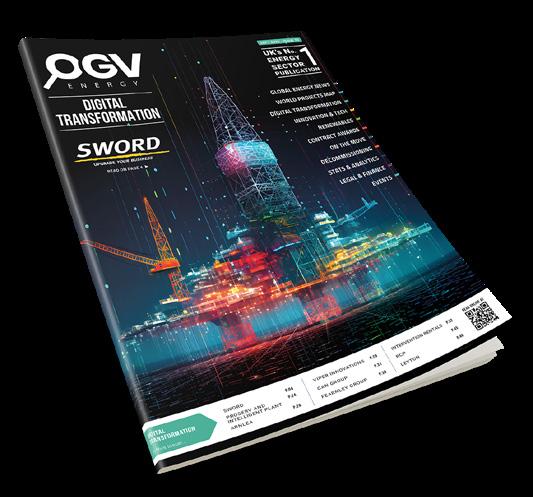
transition materials, diversified industrial businesses, and digital technologies.”
A joint venture between Técnicas Reunidas S.A. and Sinopec Engineering Group has been selected as the EPC contractor and was awarded a lump sum contract from Saudi Aramco for the Riyas Natural Gas Liquids (NGL) Fractionation Facility in Saudi Arabia, the Spanish firm said in January. Total investment arising from these two contracts exceeds $3.3 billion.
Wood has secured $850 million in contract wins in the Middle East region in 2023, the consulting and engineering group said at the end of January.
Last year, the company was involved in projects across the region including the development of a CO2 transportation and storage network that will increase the current global capacity of CO2 storage by about 25 percent, as well as feasibility studies and preliminary front end engineering design for both carbon capture and storage (CCS) and low-carbon hydrogen projects. In addition, Wood continues to support brownfield asset upgrades and expansions alongside greenfield developments to optimise operations for petrochemicals and gas producers.
ADNOC decarbonization projects to meet its 25 percent reduction in carbon intensity by 2030 include using clean energy to provide 100 percent of its onshore grid electricity needs since the start of 2022 and connecting its offshore operations to the grid through a $3.8 billion (AED14 billion) project that, upon completion, can reduce its offshore carbon footprint by up to 50 percent, the Abu Dhabi national oil company said.

Early in January, ADNOC said it had taken a 10.1-percent equity stake in Storegga to become a lead investor in the UK-based company that focuses on the development of global carbon capture and storage (CCS) projects.
QatarEnergy awarded at end-January four main Engineering, Procurement, Construction, and Installation (EPCI) contract packages, worth a total of $6 billion, for the next development phase of the Al-Shaheen offshore field, Qatar’s largest oil field, which would increase field production by about 100,000 bpd.
“We are thrilled to see continued growth across our Middle East business, where we have supported the energy industry for more than eight decades,” Wood chief executive Ken Gilmartin said.
In the United Arab Emirates, UAE President Sheikh Mohamed bin Zayed Al Nahyan directed ADNOC to grow its diversified portfolio and provide secure, reliable, and responsible energy to support the delivery of a just, orderly and equitable global energy transition. At a meeting presided by the UAE president, ADNOC’s board increased the budget allocation for landmark decarbonization projects, technologies, and lower-carbon solutions to $23 billion (AED 84.4 billion).


The winners of the four packages were a consortium of McDermott Middle East and Qingdao McDermott Wuchuan Offshore Engineering, a consortium of McDermott Middle East and Hyundai Heavy Industries, Larsen & Toubro Limited, and China Offshore Oil Engineering Co (COOEC).
QatarEnergy also announced in early February a long-term condensate supply agreement with Mitsui & Co. Energy Trading Singapore Pte. Ltd., a wholly owned subsidiary of Japanbased energy trading giant Mitsui & Co. Ltd.
The 10-year supply agreement entails the supply of up to 11 million barrels of condensates per year, starting from April 2024, the Qatari state firm said.

Brent Oil Column March 2024
Today's Price $79.67*

1 YEAR AGO

1 year ago - $79.67
Oil prices rebounded in March after dropping to their lowest levels in 15 months amid turmoil in the banking sector. Prices had come under pressure from a crisis in the Western banking sector, but it was strongly believed that the drop in prices was temporary and not underpinned by supply demand.

5 YEARS AGO
5 years ago - $66.11
BW Offshore agreed to pay Brazilian oil company Petrobras $90 million for 70% of the Maromba field offshore Brazil. The company said eight of the nine exploration and appraisal wells drilled had found oil in “multiple reservoirs” already “defined and delineated” by four wells. A billion barrels of oil were said to be the upside potential in the area.
10 YEARS AGO

10 years ago - $106.99
Plans to expand shale gas “fracking” in the UK would have to learn from leaks and poor monitoring at existing onshore oil and gas sites, scientists suggested. A review of 2,152 wells drills from 19022013 found up to 100 “orphaned” wells for which no firm was responsible.







$1 billion
CNOOC
The Chinese government has approved the Bozhong 26-6 environmental impact assessment. The project will comprise of a central processing platform, unmanned wellhead platform, four subsea pipelines and new 42.2 km gas pipeline. A total of 33 wells will be drilled, and the platforms combined will have 27 spare well slots.
$1.2 billion Navitus Petroleum Navitas and Rockhopper have identified potential FPSOs to be redeployed in the field, and an FID is expected to be reached in 2024. The companies will submit an updated environmental impact assessment with the Falkland Island authorities in Q1 2024. FEED is ongoing and CAPEX for the first phase has been reduced to US$1.2bn.
$10 billion North Oil Company McDermott has been awarded two EPCIC contracts on the project. In JV with Qingdao McDermott Wuchuan they will undertake the installation of nine satellite wellhead platforms and jackets. In a JV with Hyundai Heavy Industries, McDermott will construct a central processing platforms, a flare platform and associated bridges.
$404 million
Wintershall Dea
Wintershall Dea has been granted permission by the Norwegian Ocean Industry Authority (Havtil) to utilise Transocean's Transocean Norge semi-submersible rig. This authorisation is for the drilling of three production wells and one water injector well.
SPONSORED BY

www.eicdatastream.the-eic.com
The EIC delivers high-value market intelligence through its online energy project database, and via a global network of staff to provide qualified regional insight. Along with practical assistance and facilitation services, the EIC’s access to information keeps members one step ahead of the competition in a demanding global marketplace.
The EIC is the leading Trade Association providing dedicated services to help members understand, identify and pursue business opportunities globally.
It is renowned for excellence in the provision of services that unlock opportunities for its members, helping the supply chain to win business across the globe.
The EIC provides one of the most comprehensive sources of energy projects and business intelligence in the energy sector today.
5 6
$716 million
BW Energy
BW Energy has signed a memorandum of understanding (MoU) with Cosco Shipping Heavy Industry for the upgrade of the Polvo FPSO ahead of its deployment at the Maromba field in Brazil. The development will also comprise of a dry tree wellhead platform. The final investment decision remains subject to the conclusion of project financing activities.
$12.9 billion
ExxonMobil
Jumbo Offshore has been awarded a contract for the transport and pre-installation of the spread mooring system of the Errea Wittu FPSO. The system consists of 43km of polyester rope, 8,800 metres of chains sections and 19 suction anchors. The company will use its Fairplayer heavy-lift vessel for the contract. The FPSO mooring system, to be supplied by Modec's subsidiary Sofec, will feature 19 mooring legs.



$325 million
Conrad Petroleum FEED studies on the project have been completed. The development plans for phase 1 will see the drilling of six wells, tied back to a leased MOPU. The gas produced will then enter the West Natuna pipeline system. A final investment decision has been delayed until mid-2024 and production start-up is now pushed to mid-2026.



$10 billion
Azule Energy
Yinson has awarded TMC Compressors a contract to provide a large-capacity marine compressed air system for the Agogo FPSO. The marine compressed air system would include compressors for controlling and servicing air on board. The equipment will be manufactured and assembled in Europe before being delivered to Yinson Productions' preferred conversion yard.
8 7
$250 million
Jadestone Energy
Jadestone has signed a Heads of Agreement (HoA) with PetroVietnam for the gas sales and purchase agreement (GSPA) for the Nam Du and U Minh (NDUM) fields. FID is planned to be achieved in mid-2025 for both fields. Additionally, Jadestone is preparing to submit an updated field development plan (FDP) after geological and geophysical evaluation which is currently ongoing.


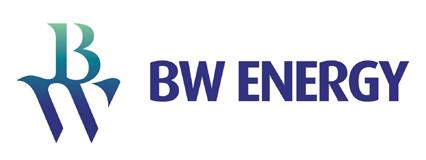
$900 million
Petronas
McDermott has been awarded an offshore contract from MMHE, involving the transportation and structural installation of a 138km pipeline section, a 15,000MT CCS platform jacket, and a bridge linking to the existing central processing platform. The installation will be carried out by one of McDermott's specialized heavy-lift and pipelay vessels.
$500 million
Harbour Energy
Technip Energies has been awarded the FEED contract for the project. Technip Energies, supported by its subsidiary Genesis, will provide FEED services for the CO2 transportation system, including the CO2 handling station, onshore and offshore pipeline and a NPAI (Not Permanently Attended Installation) platform.



$250 million
TechnipFMC has been awarded a contract by bp for the installation of pipes and umbilicals associated with the three-well tie-back project. The company will also manufacture and install pipeline end terminations (PLETs).



Effective asset management solutions help the energy industry, as well as other asset-heavy industries such as manufacturing and infrastructure, to boost the reliability, safety, and efficiency in operations as demand for energy continues to grow and governments pay increasing attention to energy security.
Proper asset integrity management systems and practices assure that offshore rigs and turbines, onshore processing facilities, producing and refining assets, pipelines, and wind and solar plants operate smoothly and efficiently, and failures are prevented.
With safety, reliability, and efficiency in mind, demand for asset integrity management solutions is growing and is expected to continue rising in the coming decades.
The global asset integrity management market is estimated to be worth US$26.8 billion this year, and is expected to be valued at US$44.4 billion in a decade, according to a report from Future Market Insights.
Between 2019 and 2023, the global the asset integrity management market had a compound annual growth rate (CAGR) of 3.8 percent.
As demand for asset integrity management is high in the oil and gas, energy, manufacturing, aerospace, and infrastructure sectors, the industry is set to register a CAGR of 5.2 percent from now until 2034, the report found.
“Many industries, such as oil and gas, energy, and manufacturing, are dealing with aging assets that require continuous monitoring and maintenance to ensure their reliability and longevity, driving the demand for asset integrity management solutions to address the challenges of maintaining older infrastructure”, Future Market Insights noted.

“The increasing technological innovations and growing regulatory compliance in various end-use industries are anticipated to drive the asset integrity management market growth during the forecast period,” commented Sudip Saha, Managing Director and CoFounder at Future Market Insights.
In the Inspection, Repair, and Maintenance market, a large share of which services the energy industry, the growth is set for 7.9 percent annually by 2029, from a US$42.66 billion market value in 2022 to US$72.46 billion in 2029, Fortune Business Insights said in a report last year.
Market growth will be driven by strong demand for efficient protection systems, the growing use of digitalisation in various industries, including the energy industry, and the acceleration of renewable capacity installations, according to the findings of the report.
Increased integration of advanced inspection technologies, including with drones and subsea remotely operated vehicles (ROVs), is also driving the innovation and growth of the asset integrity management market.
Many companies have been seeking partnerships to deploy innovative technologies in their asset management systems and processes.
For example, bp selected in November 2023 infrastructure engineering software company Bentley Systems to use its technology for an enterprise-wide approach to asset information management together with structural integrity and reliability management.
Back in 2019, bp selected Bentley to provide its AssetWise ALIM solution as a Central Information Store (CIS) to manage change in a controlled manner to maintain validated information needed for global projects and operations, including all documents, tags, associated metadata, and 3D model visualization.
bp will now standardize AssetWise ALIM across all projects, production, and manufacturing assets.
“This gives bp the assurance and advantage of accuracy of our information through effective change control, enabling us to make trusted decisions whether in projects or operations,” said Rob Kelly, VP Digital Asset Management at bp.
In June 2023, Sharper Shape, which specialises in powerline management solutions for the utilities industry through automated asset and vegetation inspection services and digital twin technology, announced a contract win with the Volatus Aerospace group of companies, formally launching Sharper Shape’s latest offering— drone service providers (DSP) management.
The service is not limited to DSPs but also arborists and inspection companies that use unmanned aerial vehicles (UAVs) to inspect or work on utility transmission and distribution systems, such as powerlines.
Researchers at the University of Houston are developing an autonomous robot to identify potential pipeline leaks and structural failures during subsea inspections, the university said in August 2023, amid an increasing number of severe accidents in the global oil and gas industry caused by damaged pipelines.

The BSEE is funding the project with a $960,493 grant to UH researchers Zheng Chen, Bill D. Cook Assistant Professor of Mechanical Engineering and Gangbing Song, John and Rebecca Moores Professor of Mechanical Engineering, who are working in collaboration with Oceaneering International and Chevron.
“By automating the inspection process with this state-of-the art robotic technology, we can dramatically reduce the cost and risk of these important subsea inspections which will lead to safer operations of offshore oil and gas pipelines as less intervention from human divers will be needed,” said Chen.
“With proper implementation, the rate of subsea pipeline failure and related accidents will decrease, and subsea operations will be free to expand at faster rate than before,” added Chen.
The technology will also be highly accurate in monitoring corrosion and will also help mitigate the chances of pipeline failure from other factors, said co-principal investigator Gangbing Song.
Apart from physical asset integrity, companies are also paying increased attention to cyber security, which has grown to become a top component of energy assets integrity, considering the rise of asset management digitalisation and the threat from growing geopolitical risks.
The threats to energy asset integrity have increased in recent years after the Russian invasion of Ukraine. Operators of such assets in Europe and the United States need to
coordination in response to attempts to disrupt critical infrastructure.
“The geopolitical context in which critical infrastructure operates is highly volatile and this not only in view of Russia's war of aggression against Ukraine, increased hybrid attacks and the sabotage of the Nord Stream gas pipelines. Citizens, businesses and authorities in the EU rely on critical infrastructure because of the essential services that the entities operating such infrastructure provide,” the Commission said.
“Cyber threats will continue to evolve and become both more frequent and more powerful, given the established business models of cybercriminals and the wide range of advanced technologies at their disposal,”
“Such services are crucial for the maintenance of vital societal functions and must be provided in an unobstructed manner in the internal market.”
The Critical Infrastructure Blueprint has three objectives—improve shared situational awareness, ensure coordinated public communication, and provide effective response by strengthening the response of Member States and cooperation between Member States and with relevant Union institutions, bodies, offices, agencies, will mitigate the effects of a significant critical infrastructure incident and enable swift reestablishment of essential services.
In the United States, the Department of Energy (DOE) announced in January 2024 up to $70 million in funding to support research

the resilience of America’s energy systems, which include the power grid, electric utilities, pipelines, and renewable energy generation sources like wind or solar.
Cyber research and development and physical security research and development are two of the several proposed topic areas for the projects.
The energy industry is more aware of cyber security threats and is increasing investment to address them, according to a survey of 600 energy professionals carried out by DNV. The increased awareness comes amid heightened geopolitical tensions, emerging compliance requirements, and the accelerating adoption of digitally connected infrastructure, DNV’s Energy Cyber Priority 2023 report found.
The International Energy Agency (IEA) also acknowledged in a 2023 commentary that cyberattack trends “pose an unprecedented threat to critical infrastructure, such as electricity systems.”
“Cyber threats will continue to evolve and become both more frequent and more powerful, given the established business models of cybercriminals and the wide range of advanced technologies at their disposal,” the IEA’s Energy Data Officer Marc Casanovas and Aloys Nghiem, Data Development and Support Lead (Acting), wrote.
“It is therefore essential that every power utility, big or small, includes cybersecurity as a core element of their business strategy and ensures access to inhouse cybersecurity professionals and their skills, continuously updating them and ensuring talent retention.”
Enormous efforts are being placed on the acceleration of AI and innovative technologies to increase sustainability, streamline industry practices and improve partner synergies.
It is vitally important, however, for companies to remain conscious of what makes evolution and progress possible; the solid foundation of safe and reliable working processes and environments.
With the buzz and speed of day-to-day life, it is easy to get caught up in the delivery and execution of cutting-edge developments, but it’s vitally important we do not lose sight of what makes success feasible.
Making time to prioritise safety is undeniably paramount. Essential practices such as reviewing internal policies, staying up to date with industry and regulatory changes, implementing improvement opportunities and promoting a “Safety First” culture are key fundamentals to safeguarding the people and equipment that facilitate advancement.
It is worrying to see the frequency of dangerous situations re-occurring in daily headlines across all occupational sectors underlining organisations that have overlooked the vital importance of safety in everyday operations. These momentary lapses of judgement can lead to considerable damage to assets, penalties, and physical injuries or worse.
At Flare, we aim to reduce safety incidents with our 360o “Safety First” approach. Our core commercial divisions integrate the service and maintenance of critical safety equipment and systems that are positioned onboard installations worldwide. We strictly adhere to safety standards, industry regulations and certification bodies to ensure high-quality, verified project deliveries.
Flare’s Specialist Safety Services portfolio incorporates over 21 service activities covering everything from safety equipment inspection and recertification through to comprehensive safety systems refurbishment, testing and analysis.
Our award-winning Annual Fire-Fighting Equipment Service is enhanced by our additional tiers of expertise ranging from Engineering & Systems Design Services, Pressure Safety Valve & Critical Gauge Recertification Services, Hazardous Environment Specialist Services and Safety Product Sales & Hire Divisions.
Safety is indispensable to the smooth operation and performance of installations & assets across the globe, playing a crucial role in reducing risks, protecting against harm or damage, and ensuring optimal output while safeguarding those in the field.
“Safety First” is the thread that binds our dynamic team together and sets us apart. This principal pillar of integrity is the unwavering backdrop for our organisation and it underpins the foundation of who we are. Coupled with our celebrated customer focus and unrivalled technical knowledge, we continue to expand our reach to networks around the globe, supporting positive change in the Energy world and contributing to a safer and greener future.
Flare approaches challenges with unwavering resolution and determination and are looking to the future with optimism and excitement. As we embark on our next chapter of safety excellence, we will be revealing several new commercial ventures that include international partnerships and expansion into new territories. We continue to invest in meaningful innovation and have increased our asset portfolio to include a fleet of offshore workshop containers, new hire equipment ranging from portable gas & NORM detection, breathing apparatus & life-saving equipment as well as our exclusive series of Zone 1 Breathing Air Compressors.
By maintaining peace of mind to our regional and international industry partners, we continue to promote our safety expertise that has been relied upon for a decade, underpinning enhanced asset integrity and top-tier operational success.





ICR
Group continues to redefine asset integrity with its revolutionary Technowrap™ product.
This repair solution is designed to be a flexible solution and can enhance operational efficiency and sustainability, while minimising downtime and environmental impacts.
replacement, enabling repairs to be conducted without the need for operational shutdowns.
Repairs can last for up to 20 years. Moreover, Technowrap™ can contribute to environmental sustainability by offering a 66% reduction in carbon emissions compared to traditional replacement methods.
Ewan Robertson, Global Composite Repair Director at ICR, said: “Technowrap™ is the ideal product for assets to keep in their toolbox to cover a myriad of maintenance and repair applications for pipework and infrastructure. This technique has now had a 30-year track record in the industry and can provide further advantages from a sustainability and efficiency perspective.”

By harnessing the strength of glass or carbon fibre stitched cloths paired with two-part epoxy resins, Technowrap™ rehabilitates damaged pipework, pipelines and structural components across various scenarios.
ICR’s comprehensive in-house approach encompasses engineering, material provision, technician training and installation, ensuring quality and reliability.
The versatility of Technowrap™ is evident in its broad range of applications, from pressurised systems and pipelines to structural repairs of tanks, vessels, caissons, risers and even underwater environments. It offers a cost-effective alternative to steel
The ICR portfolio also boasts INSONO™, an innovative non-destructive testing (NDT) technique for inspecting engineered composite repairs.
Furthermore, ICR's online leak sealing solutions provide tailored, in-house engineered clamps and repairs designed to tackle specific leaks in operational systems.
Quickflange™ offers another remarkable solution within ICR’s arsenal, delivering weldless, high-performance flange-to-pipe connections that improve pipeline integrity and flow assurance. This is a permanent, efficient repair option, yielding up to 80% time savings and a 57% reduction in greenhouse gas emissions compared to traditional welding methods.
ICR’s machining and bolting capability brings extensive experience to a wide range of industrial sectors. Meanwhile, the firm’s drone division, Sky-Futures, delivers inspection reports and supported an operator by measuring methane emissions at four platforms in the North Sea.
For further information visit: www.icr-world.com

Are you ready to discover if your potential is within reach?


The energy industry is currently going through it’s biggest change in living memory, and there is a significant push towards decarbonising the UK’s industries to create a greener future. With set targets to be net-zero by 2050 and with the release of the UK Government’s comprehensive Carbon Capture, Utilisation, and Storage (CCUS) vision last year, attention is turning to transform the oil and gas industry.
Subsea technologies are key players in decarbonisation, and ROSEN’s innovative solutions are driving this shift. Through its impressive track record for pipeline integrity, ROSEN Group is strategically positioned to leverage and align seamlessly with this initiative, using its experience to navigate challenges and capture opportunities in the move towards a low-carbon future.
In Carbon Capture and Storage (CCS), success relies on strong subsea infrastructure. ROSEN’s advanced inspection and monitoring technologies play a crucial role in ensuring the integrity of subsea pipelines and storage facilities. Their commitment not only reduces the risks associated with transporting and separating captured carbon dioxide, but also enhances safety and reliability, making a substantial contribution to mitigating greenhouse gas emissions from industrial processes.

As the exploration of green hydrogen gains momentum, subsea technologies take the lead in offshore hydrogen production. ROSEN supports pipeline operators seeking to converting their pipelines to hydrogen with a phased approach documented by its hydrogen integrity framework. This ensures reliable hydrogen transport operations, addressing performance, safety, and security that is crucial for a successful hydrogen economy.
De-risking the energy transition involves tackling challenges proactively. ROSEN’s innovative solutions in integrity corrosion management ensure the durability and longevity of subsea assets exposed to harsh environmental conditions.
With its consultants, inspection technologies and hydrogen testing lab, ROSEN offers a unique combination of services that provide clients with a comprehensive approach to repurposing assets to from carbon-based fuels to future fuels.
ROSEN positions itself as a trusted partner in de -risking the energy transition through visionary subsea technologies. As the world moves towards a low-carbon future, ROSEN’s unwavering dedication to excellence in subsea engineering becomes a cornerstone in the success of derisking decarbonisation efforts.





ate last year, Proserv secured another notable contract in the Middle East for its Abu Dhabi based service operation.
The award was with one of the region’s biggest energy companies relating to the maintenance of critical explosion proof offshore equipment. This is a client we work with regularly, across its vast assets, and so it represented a really satisfying win, reinforcing our on-going relationship.
So, all good. But the real story here lies in the back story. What makes this special for us is that five years ago, we couldn’t have considered bidding for this particular tender, let alone winning it, as it was beyond our then current offering.
Such has been our direction of travel with this customer that landing regular contracts, often multi-year agreements, has become a normal occurrence – something we value greatly every time.
But this one was a little different. Why?
Because it signifies the culmination of a long-term strategy and evolves from years of constructive relationship building. It speaks to collaboration, trust and innovation.
We must go back to 2019 to see the origins of this win. At that time, such was the consistent quality of our output as a team, that we discussed with the client where else across its extensive business we might be able to bring additional skills. We forged a collaboration from our dialogue, bolstered by the growing trust.
This played a part in our decision to acquire the Abu Dhabi team of Dron & Dickson, with its electrical engineering know-how, specialising in the supply and maintenance of zone rated products for use in hazardous areas and explosive atmospheres.
This was a skill set we didn’t possess but it would expand our portfolio and widen our already well-regarded bandwidth even more. To fast forward to 2024 and see that very team at the centre of the delivery of this

contract not only validates our decisionmaking but equally allows our collaborative relationship with the client to extend.
As a service provider, gaining trust takes time and has to be earned. But it is the central component of building long standing commitments. The fact we can now engage in high level planning and strategy discussions, alert to the customer’s future needs and anticipating them, empowers both parties.
But that next contract or opportunity is never a given. So while we now had the necessary skills to deliver the maintenance of this explosion proof equipment, our team needed to convince the client of what we could execute, make sure the tender was entirely on message and look to see how we might generate more value via additional capabilities.
Through tracking codes and identification tags, technicians on-site can use their tablet, even offline, to target a specific piece of equipment and scrutinise its inspection history or schematic drawings, quickly able to pinpoint exactly what they need to check. By utilising Wi-Fi, any actions taken can be picked up directly in the control room or office at the same time.
The industry increasingly expects smarter and swifter ways of retrieving actionable information. We are currently looking to integrate our next generation SmartBox 2.0 remote well-monitoring solution to work alongside our Asset Intelligence platform. SmartBox can detect H2S leaks, unplanned failures and can even enable a remote emergency shutdown in the event of a problem.
“…our new Asset Intelligence platform… is an exciting software solution that can deliver a transformative shift in day-to-day operations and maintenance planning.”
Through presentations to stakeholders within the client’s operations team, we were able to augment our offering with our new Asset Intelligence platform. This is an exciting software solution that can deliver a transformative shift in day-to-day operations and maintenance planning. Fundamentally, this is about optimising the way of doing things.
On this specific project, daily status reports, design drawings, certification and testing histories, and inspection timelines will be collated in one accessible place. The client will know how critical equipment is performing and when it next requires physical inspection. More broadly, our Asset Intelligence solution brings a reliability and certainty to processes. If infrastructure is at risk of becoming obsolete, our tool will flag that up, or if urgent intervention is required and relevant documentation is needed in a hurry – it is only a click or two away.
Data captured in real-time by SmartBox from offshore, or out in the inaccessible desert, might indicate a developing issue. Harnessing the capability of Asset Intelligence as a repository of documentation, an asset manager could immediately reference previous inspection histories to gain insights and plan future intervention.
From strategy planning several years ago, regarding widening our skill sets, through to securing a significant contract as a direct result of that bold decision-making, this patient, gradual journey represents a true case study of how we continue to build our business.
The trust we have nurtured with this important client means we can seek to augment our offering with newly innovated solutions to bring them greater value across their processes –and so the collaboration grows.


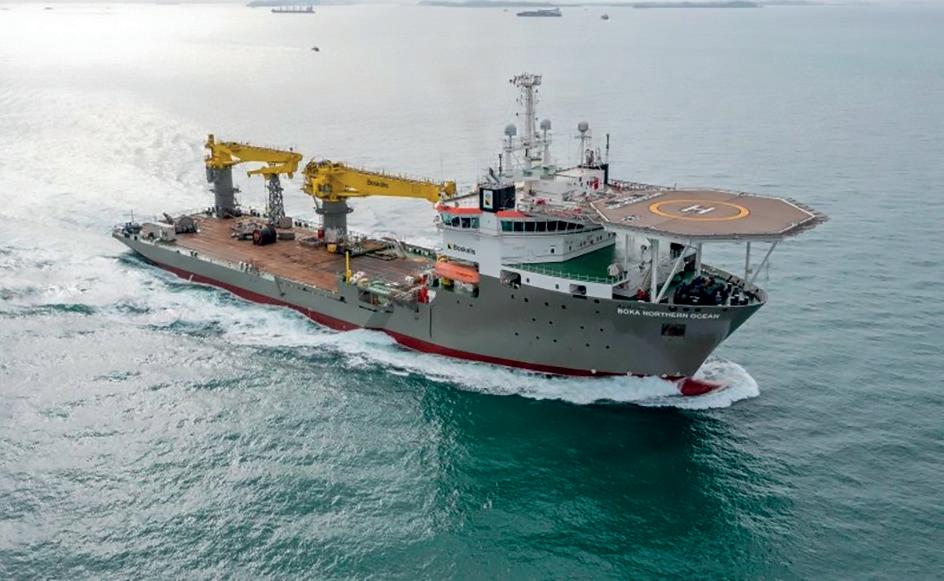
ROVOP announces long term global partnership with Boskalis Subsea Services to deliver integrated subsea solutions throughout the energy industry
ROVOP, a global supplier of ROV services and the Aberdeen based Boskalis subsidiary Subsea Services, a leading subsea provider of IRM, Construction and Decommissioning services, has announced a global partnership.
The partnership provides five diving support vessels (DSV) and one construction support vessel (CSV) of the Boskalis fleet, with dedicated ROV services to maximise service delivery, efficiency, flexibility and capability.
The partnership will see the placement of 7 ROVOP ROV systems across these DSVs and CSV for a minimum 3-year period on an international basis. ROVOP will also mobilise additional ROV systems on an ad hoc basis as required.
ROVOP’s diverse fleet of vehicles allows for varying configurations onboard the Boskalis Subsea Services fleet depending on the end client requirements. This partnership is an extension of an existing relationship, which sees significant cooperation between both companies both on and offshore.
Driven by increased demand and limited supply in the subsea market, this agreement enhances supply chain reliability. Being enabled with the right ROV operated by the right skilled offshore personnel is key in delivering efficiency and consistency across projects.
Crucially, the placement of ROVs across the six Boskalis assets drives increased safety performance as the ROVs act as an additional visual support for diving operations. Furthermore, it enables the ability to carry out diverless tasks, such as cutting and recovery.
Stuart Cameron, Boskalis Subsea Services Managing Director, said ‘’I am delighted to share the news that we have furthered our long-term relationship aimed at delivering exceptional diving and ROV services. This collaboration not only strengthens our capabilities but aligns perfectly with the addition of the CSV Northern Ocean to our fleet, further solidifying our commitment to the North Sea and evolving needs of our clients.’’
Neil Potter, ROVOP Chief Executive Officer, said “It is my pleasure to announce that ROVOP’s operational performance in recent years has been recognised through this partnership. Boskalis Subsea Services are known for their strength in vessel and diving based service delivery and we believe our ROV service, delivered by our world class personnel, will be complementary and combine to offer a market leading solution to the global offshore energy industry”.


Across the diverse energy sector, asset integrity is fundamental to ensure safe and effective operations.

As the industry evolves, so do the challenges associated with managing integrity assurance. Amidst the ever-changing landscape, Plant Integrity Management Ltd (PIM) remains a reliable player, offering a unique blend of ever growing Structural Integrity Management (SIM) capabilities.
Drawing on over a decade of expertise in Pressure Systems and Technical Safety, PIM has steadily broadened its scope to include the wider area of SIM. In a competitive market where established names prevail, PIM distinguishes itself through its combination of technical proficiency and operational experience. Our team comprises engineers who have previously held various roles, from senior duty holder leadership to hands-on inspection work, giving us the adaptability to address diverse challenges with practical solutions. At PIM, we recognize that SIM requires more than just technical know-how; it demands a nuanced understanding of current operational realities. This insight enables us to offer comprehensive support, ranging from core integrity services to the development, implementation, and refinement of Structural Integrity programs. By leveraging our expertise, we empower our clients to navigate the complexities of Structural Integrity with confidence.
Our commitment to excellence extends beyond our internal capabilities. Understanding the value of collaboration, we have formed strategic partnerships with local businesses which not only enhance our technical capabilities but also foster innovation and adaptability. By pooling our expertise, we ensure that our solutions remain tailored to our clients' specific needs, while retaining the flexibility that defines PIM's approach.
As we continue our journey, eagerly anticipating future innovations and progress, PIM and the energy industry as a whole are poised for an exciting future. The evolving challenges within SIM present opportunities for growth and advancement, and PIM is ready to meet them with determination. We look forward to collaborating with industry stakeholders, addressing challenges together and driving meaningful change.
PIM's journey towards enhancing SIM capabilities reflects our steadfast commitment to excellence and innovation. As we navigate the ever-changing energy landscape, we invite you to join us. Whether you need core integrity services or comprehensive program solutions, PIM is here to offer tailored assistance.

Digital technology is all around us. We’re using it for almost every aspect of our daily lives from banking, shopping, to keeping in touch with friends and family.
In recent weeks we’ve seen the Horizon Scandal dominating the news where hundreds of postmasters were wrongfully accused of theft and many convicted as the result of what was essentially a programming error in a piece of critical software. Has this scandal and other recent “algorithm” based controversies, such as the exam results fiasco during the covid pandemic, affected our relationship with technology?
Whilst it’s clear we won’t be “breaking up” with technology any time soon, hopefully stories like these, whilst shocking for those affected, serve to remind us all that technological solutions are not infallible, they are designed and built by humans who, just like all of us, are capable of making mistakes. The big difference is that it’s impossible to hold a piece of software accountable for its mistakes.
This brings back memories of the “computer says no” sketch from ‘Little Britain’ in the early noughties, whilst intended to be a parody of such blinkered assumptions, this has sadly become reality in the case of many organisations as a drive to cut corporate ‘human’ overhead costs. As a result, more processes are fully automated and whilst there have been many successes, it can sometimes result in failure, as was the unfortunate case with the post office system.


As an Asset Integrity specialist, CAN Group sees the benefits of software and Artificial Intelligence (AI) as an assistive technology to enhance the work of our experienced and qualified teams, not to replace it. If an AI tool says an inspection of a piece of plant equipment isn’t required and later results in a major issue, will the AI tool be apologising for the failures to the regulators on your behalf? Of course not. Ensuring that the decision-making process is led by an empowered, integrated and highly experienced workforce, who are aided, not replaced, by technical innovation for safety critical inspections, can help to ensure safety and certainty for years to come. Don’t look as far as the horizon when the solution is closer to hand; CAN Group, harnessing the power of people, process and technology.


In the dynamic world of subsea oil and gas exploration, maintaining the integrity of assets is paramount to ensure safety, optimise production and mitigate risks. The Impulse Group specialises in providing comprehensive asset integrity management services tailored to meet the unique needs of subsea operations worldwide.
Martin Harbottle, Technical Director at The Impulse Group, shares his expertise below about how the team of experts at The Impulse Group can enhance asset integrity in your subsea oil and gas operations.
Effective inspection planning is the cornerstone of asset integrity management. A customised inspection plan, tailored to specific assets and operational requirements can minimise downtime and maximise asset performance.
Annulus testing is a critical benchmarking tool to understand the current performance of fundamental integrity related components within the flexible pipe design. It is critical to know if there is a breach to the outer sheath and ideally to know where that breach may be located. It is also preferable to know if the vent ports are open and venting annulus gases to the venting system as well as knowing the constituents of that gas. This allows the risk assessment to be carried out with real information and trending, which can lead to enhanced integrity understanding.
Managing risks effectively is essential to safeguarding assets and personnel in subsea environments. Risk management can encompass field risk assessments, Hazard
Identification and Risk Assessment (HIRA), Hazard and Operability Studies (HAZOP), Failure Mode and Effects Analysis (FMEA), and more. By identifying, assessing, and mitigating potential risks, you can minimise operational disruptions and enhance safety performance.
Effective risk management is a continuous process, and by fostering a culture of safety and risk awareness, the likelihood of incidents is minimised whilst personnel, assets and the environment are better protected.
Understanding the remaining useful life of subsea assets is crucial for informed decision-making and long-term planning. Remnant life assessment and extension services utilise advanced techniques and predictive modelling to evaluate asset condition, assess degradation mechanisms and determine remaining service life. This enables you to optimise asset utilisation and minimise unplanned maintenance activities.
Ensuring that subsea assets remain fit for their intended service throughout their operational life is essential for maintaining reliability and performance. Fitness for service assessments evaluate the structural integrity and functionality of assets, taking into account factors such as material properties, environmental conditions and operational

loads. By identifying any deficiencies or vulnerabilities, timely corrective measures can be implemented to extend asset longevity.
In the event of anomalies or defects detected during inspections, prompt intervention and repair are crucial to prevent potential failures and maintain asset integrity. For example, The Impulse Group offers a comprehensive range of intervention and repair products designed to address various subsea challenges, from pipeline repairs to structural integrity enhancements.
Successful asset integrity management begins with meticulous planning and preparation. Whether it's developing comprehensive integrity management plans or providing expert advice on materials selection and procurement, our team can support every stage of the asset lifecycle.
At The Impulse Group, we are committed to helping subsea oil and gas companies reduce risk, enhance operational efficiency and maximise production through our comprehensive asset integrity management services.



It is a little over twenty years since the Working Time Directive was extended to the offshore sector giving workers in oil and gas an entitlement to paid holiday. In the two decades that have followed there has been a raft of disputes centred around their holiday arrangements. Now, new legislation brings about changes to the annual leave accrual and holiday pay regimes for some offshore energy workers.
The Employment Rights (Amendment, Revocation and Transitional Provision) Regulations 2023 came into force on 1 January 2024. These regulations, which amend the Working Time Regulations 1998, introduce new rules on annual leave accrual and holiday pay for irregular hours and partyear workers. The new rules apply to holiday years starting on or after 1 April 2024.
Some workers in the offshore energy sector will be classed as irregular hours workers and others may be part-year workers, both of these groups are affected by the changes. Employers in the sector will, therefore, need to carefully review their contractual arrangements and working practices and consider which, if any, of their workers fall under these classifications.
This is unlikely to be a simple exercise. These are new legal concepts, and it is not yet clear how the legislation will be interpreted where there is ambiguity. It may assist to consider the Government guidance document:
Holiday pay and entitlement reforms from 1 January 2024. However, the guidance warns that it does not provide definitive answers to individual queries. It also states that it is not intended to be relied upon in a specific context.
The changes impact those who are classed as an irregular hours worker or a part-year worker. A worker is stated to be an irregular hours worker, in relation to a leave year, if the number of paid hours that they will work in each pay period during the term of their contract in that year is, under the terms of their contract, wholly or mostly variable.
 Fiona Herrell, Partner Employment & Immigration, Brodies LLP
Fiona Herrell, Partner Employment & Immigration, Brodies LLP
A part-year worker is someone who, under the terms of their contract, they are required to work only part of that leave year and there are periods within that year (during the term of the contract) of at least a week which they are not required to work and for which they are not paid.
Under the new regime, holiday for irregular hours and part-year workers will accrue on the last day of each pay period at the rate of 12.07% of the actual hours worked in that pay period, up to a maximum of 28 days per year.
This means that these workers will build up holiday entitlement as they work over the year rather than getting it all at the start of the holiday year. There are special rules for accruing holiday during sickness and family related leave. Also, the distinction that exists
between basic leave and additional leave for workers with normal working hours (for holiday pay calculations and carry over rights) will not exist.
Employers will be able to choose from two systems of paying holiday pay to irregular hours and part-year workers:
1. Pay holiday pay when holiday is taken, using an average from the last 52 weeks in which the worker worked and was paid. Calculations will be required every time holiday is taken.
2. Pay rolled-up holiday pay, payable as an uplift of 12.07% to the worker's total remuneration for work done in each pay period. Rolled-up holiday pay must be paid at the same time as pay for the work done and shown as a separate item on payslips.
Irregular hours and part-year workers will have their statutory holiday entitlement paid at a rate based on their total pay (including any 'task, status and regular payments'), whether it is calculated as rolled-up holiday pay or by reference to the previous 52 weeks.
There will be special rules for calculating a week's pay and rolled-up holiday pay for workers who have been on sick leave or family related leave.
If irregular hours or part-year workers are identified, consideration will need to be given to the required changes to current entitlements, arrangements and practices relating to holiday accrual and holiday pay, and also the communication of the new regime to impacted workers.


Brodies LLP is a UK top 50, and leading Scottish, law firm with offices across Scotland, the UK and internationally. For more useful insight and details of our energy expertise visit brodies.com

www.leyton.com
Leyton is an international consulting firm that helps businesses leverage financial nondilutive incentives to accelerate their growth and achieve long lasting performance. We simplify your access to these complex incentives. Our combined teams of highly skilled Tax and Technical specialists, enhanced with cutting-edge digital tools developed internally, maximise the financial benefits for any type of businesses.
With compliance always front of mind, we have been delivering optimal services for our clients for over 24 years. This provides peace of mind that you will always receive the maximum benefit, without taking risks.

In the current landscape of the Oil & Gas sector, ensuring asset integrity is key for sustained operations, safety, and profitability.
With the emergence of new and cuttingedge technologies, the industry is witnessing a shift towards more proactive and data-driven approaches to asset management. Among these advancements, Fibre Optic Sensing (FOS) systems are transforming well management strategies, particularly in the UK.
Advances in FOS technology has emerged as a key player in the area of asset integrity management. In particular, by transmitting data as light, fibre optic cables offer
substantial improvements in efficiency over copper in the form of higher bandwidth and lower signal attenuation in the same form factor. While copper wires can be cheaper to install, fibre optic cables do not need to be maintained or replaced as often. By deploying optical fibres along wellbores, operators gain real-time insights into critical parameters such as temperature, pressure, and strain. This continuous monitoring enables early detection of potential issues, allowing for timely intervention and mitigation strategies. Moreover, the granular data obtained through FOS facilitates precise reservoir management and optimised production, leading to enhanced asset performance and longevity. The integration of FOS technology not only enhances operational efficiency but also drives significant economic benefits. By proactively addressing integrity issues and optimising production, operators can realise substantial cost savings over the lifecycle of a well. Furthermore, the ability to make informed decisions based on real-time data minimises downtime and mitigates risks, thereby safeguarding both assets and personnel.
In the UK, where technological innovation is a foundation of the Oil & Gas industry, the adoption of advanced asset integrity solutions underscores the commitment to sustainability and innovation. As the sector navigates through technological uncertainties and complexities, initiatives like FOS represent a proactive approach towards ensuring the long-term viability of assets amidst evolving challenges. As companies embrace technological advancements to enhance asset integrity, it is crucial to explore avenues for financial support and recognition of innovative efforts. The HMRC’s R&D Tax Relief Scheme offers a valuable opportunity for firms engaged in pioneering projects to recoup substantial costs incurred in research and development. Partnering with experts like Leyton can streamline the process of accessing R&D funding, ensuring that companies receive the maximum benefits for their innovative endeavors.
For more information visit: leyton.com




Upcoming CfD funding round to determine whether Scotland can deliver the level of offshore wind capacity the UK needs to meet net-zero Scottish Renewables calls on UK Government to unlock Scotland’s world-class renewables pipeline

Ahead of funding for the next Contracts for Difference (CfD) auction set to be announced next month, industry body Scottish Renewables has called on the UK Government to act now if Scotland is to unlock its world class pipeline of offshore wind projects in line with its climate ambitions.
The budget for CfD Allocation Round Six (AR6) will determine whether Scotland can enable the level of deployment needed for the UK to meet its net-zero targets and confirm its reputation as a world-leader in renewable energy.
In a letter to Claire Coutinho MP, Secretary of State for Energy Security and Net-Zero, Scottish Renewables has urged the UK
Government to maximise the number of offshore wind projects capable of being successful in winning contracts through this year’s CfD allocation round.
Following the failure of last year’s CfD auction to attract any bids from offshore wind developers the renewable energy industry believes that at least 10GW of offshore wind projects need to be successful in AR6 for the UK to remain on track for its 2030 target.
Scotland is poised to power the UK’s future energy needs and boost the economy with a world leading pipeline of offshore wind projects including the 30GW ScotWind leasing round and the Innovation and Targeted Oil & Gas (INTOG) 5GW leasing round.
To capitalise on the potential from all renewable technologies, Scottish Renewables recommends the UK Government delivers the following priorities in AR6:
• Set an auction budget which maximises the capacity procured across all technologies.
• Adjust reference prices and load factors for all technologies. Accurate reference prices and load factors are critical to maximising the capacity that the auction budget can procure.
• Introduce a ringfenced budget for floating offshore wind.
Increase the budget ringfenced for tidal stream projects.
Claire Mack, Chief Executive of Scottish Renewables, said:
“Now is the time to incentivise investment in Scotland’s offshore wind sector, bolster domestic supply chains and supercharge the world class offshore wind pipeline that is set to power our net-zero future.
“The UK Government faces a choice between further energy insecurity or future economic prosperity. With the UK remaining one of the most gas dependent economies in Europe, underperformance in AR6 will leave UK consumers less energy secure and more exposed to high, volatile gas prices.
“It is therefore essential that the UK Government provides a budget for AR6 that aligns with Scotland’s renewable energy ambitions and maximises the number of projects across all technologies that are successful in winning contracts.
“Scottish Renewables looks forward to continuing to work closely with the UK and Scottish Governments to drive the collaboration that will achieve our bold decarbonisation targets and deliver cheaper, cleaner power for consumers.”


brings access to technology, networks plus the knowledge and experience to implement solutions.
Commenting on joining Intervention Rentals, Pete says “I am a strong advocate of waste and water effluent treatment.


Intervention Rentals are continuing to invest in sustainable technologies & incentives and have created a new Sustainable Solutions division to expanded into the Agri, Water and Food & Drink sectors, bringing the same level of execution, technical support and environmental focus as they have been delivering in the energy markets.
In early 2023, Intervention Rentals began a journey to net zero by 2030, achieving scopes 1 & 2 and planning their PAS2060 roadmap, ensuring a drive towards a greener future not only for their operations but for their clients and the supply chain which they support.
Pete Meldrum has joined the Intervention Rentals team to head up the new Sustainable Solutions division for Intervention Rentals.
Pete has been in the energy sector for over 35 years and made the switch to renewables over 8 years ago. He has predominantly been in ops, technical & engineering roles and has also been in customer facing BD functions. Finding solutions to problems is key to Pete’s thinking.
He has introduced time, cost, and resource benefits to the Agri and Food & Drink sectors, primarily in distilleries where he has made millions in savings for site owners. Pete
Intervention Rentals match my drive for sustainable, measurable, and greener solutions and I welcomed the chance to drive the company in to non-energy markets. I avidly embrace and pioneer new, disruptive, leading-edge technologies that process co-products from ‘waste’ streams. It is essential to deliver innovative water treatment solutions whilst driving operational efficiencies and adding value through by-product creation, especially in distilleries and Food & Drink”.
“The key is reducing greenhouse gas emissions and taking harmful carbon strategies off our roads. By reducing the operations and logistics that are currently in place, we can save the customer money, cut GHG emissions and plan a better future”.
Intervention have agreed distributor agreements with Proteus Multi-meters and Axium Engineering to help them deliver realtime technology solutions.
The Proteus range of multiparameter sensors represents a step change in real-time monitoring of dissolved organic matter. The state-of-the-art monitoring platform incorporates the latest technology to provide accurate, reliable and minimal maintenance monitoring of Biochemical Oxygen Demand (BOD) and Dissolved Organic Carbon (DOC).
Axium Process specialises in Hygienic Engineering, with particular expertise in Filtration and Membrane Separation Technology. Their diverse customer portfolio includes the Aerospace, Nuclear, Pharmaceutical, and Biotech industries as well as Dairy, Food, Beverage and Chemical sectors.
Alex Leddy, Commercial Director for Sustainability states, “water is at the heart of everything that our customers in the Agri and food & drink sectors do, and they consume and repurpose an incredible amount of it. Cutting down on their treatment and logistics with a circular economy focus will benefit the opex and capex of our clients and provide positive carbon reduction results. By partnering with companies such as Proteus and Axium, we can ensure the very best in technology is coupled to the sectors who are leading the way in managing their resources and operations.”


SPONSORED BY

Infinity Partnership is an award-winning, multi-disciplinary accountancy and business advisory practice, with a proactive approach to customer service.
Infinity has been a five-time winner at the British Accountancy Awards and has been a three-time finalist at the Scottish Accountancy Awards in recent times.
Wood drives significant growth in Middle East with $850 million of contract wins

Source: Energy Northern Perspective
Wood’s growth is driven by demand for conventional and low carbon energy supply, focusing on decarbonization, energy optimization, asset life extension and energy transition solutions.
Working in Iraq, the Kingdom of Saudi Arabia, Qatar, and the UAE, Wood recently recruited over 700 new employees across the region and is currently recruiting 500 roles with more expected throughout 2024.
Ken Gilmartin, CEO at Wood said, “As a key strategic region for Wood, we see continued growth and opportunity across the Middle East. We have supported energy security in the region for more than eight decades and are excited to play a key role in its energy transition, designing a lower carbon, digitally enabled future.
“Our recent success is testament to the hard work and dedication of our remarkable team and our unwavering commitment to delivering exceptional value for our clients and developing our in-country talent.”
In the last year, Wood’s most notable wins have included:
Groundbreaking projects across the region including the development of a CO2 transportation and storage network that
will increase the current global capacity of CO2 storage by approximately 25%, as well as feasibility studies and preliminary front end engineering design for both carbon capture and storage (CCS) and low carbon hydrogen projects.
• A contract extension in Iraq with a longterm client to continue delivering front end engineering design (FEED), procurement and EPC contract management solutions, critical to safe and efficient operations. Wood is also supporting a significant project to reduce emissions in the country by more than 10 million tons of carbon per year through the elimination of flaring.
• A long term multi-million-dollar engineering and procurement services contract in Qatar
• Complex pre-FEED and FEED services for both onshore and offshore clients in the UAE.
• Committed to developing local engineering talent, Wood’s four-year engineering Basrah Graduate Scheme in Iraq continues to grow and has now supported more than 60 University of Basrah graduates since 2016.
Wood has more than 3,000 employees across the region in key hubs including the UAE, Saudi Arabia, Iraq and Qatar.

DeepOcean Gets Pipelines Inspection Job in North Sea

Ocean services provider DeepOcean has been awarded a contract by Equinor to deliver pipeline inspection and survey scopes on the operator’s pipelines in the North Sea.
In addition to its extensive infield pipeline networks, Equinor also has operational responsibility for the world's most extensive subsea pipeline system for transportation of gas.
The latest contract is an additional award under DeepOcean’s frame agreement with Equinor for the provision of offshore survey services.
“Equinor is the largest operator on the NCS and Europe’s leading energy provider through both oil and gas and renewable energy assets. We are proud to continue to support Equinor with subsea services in the North Sea. We will utilise the vessel Edda Flora with our Superior Survey ROV to perform the survey work,” said Trond Hagland, Commercial Manager - Survey & Inspection at DeepOcean..


Norwegian offshore vessel owner DOF has been awarded a contract by Altera Infrastructure to install FPSO and FSO units for the Phase 2 development of the Eni-operated Baleine field offshore Ivory Coast.
The project includes the complete installation of seabed mooring systems, flowline between the FSO and the FPSO along with associated equipment.
DOF`s contract scope includes project management, engineering, transportation, installation, and hook-up of floating units in the field. DOF shall mobilize the Skandi Skansen anchor handler to the project, totalling more than 130 vessel days.
Project management and engineering will begin immediately from DOF`s offices in Bergen and Aberdeen. Offshore operations are planned to take part in the third quarter of 2024.
Altera Infrastructure previously landed contracts with Eni for its cylindrical-shaped FPSO Voyageur Spirit and the shuttle tanker Nordic Brasilia. The vessels will be deployed on the Baleine field under a 15year firm contract. The 2004-built shuttle tanker will be converted into an FSO to provide additional storage capacity for the FPSO. Altera owns and operates both vessels.
Other contracted companies for work on the Baleine project were Baker Hughes for the provision of eight deepwater trees, three Aptara manifolds, the relevant subsea production control system, and flexible risers and jumpers while Saipem won a drilling contract worth $400m for the 7th generation drillship Deep Value Driller.
The Baleine prospect represents the largest commercial discovery in the country in the last 20 years and it is expected to contribute to energy production in Ivory Coast and strengthen the country’s role as a regional energy hub.
The development is also Africa’s first net zero emissions project, covering scopes 1 and 2. The development of the project will be on a fast-track schedule, with a planned start-up date for Phase 2 in the fourth quarter of 2024..


TechnipFMC has been awarded a substantial contract by Shell for the first integrated engineering, procurement, construction, and installation project to use high-pressure subsea production systems rated up to 20,000 psi (20K) for the Sparta development in the deepwater US Gulf of Mexico. TechnipFMC defines a substantial contract as one valued between $250 million and $500 million.
The contractor will manufacture and install subsea production systems, umbilicals, risers, and flowlines for the development in the Garden Banks area of the Gulf of Mexico. The tree systems will be Shell’s first to be qualified for 20K applications and are engineered to meet the highpressure requirements of this greenfield development.
Shell previously awarded the construction of the Sparta floating production unit (FPU) to Seatrium. The system will be the third “sister” platform built by the Singapore yard for Shell following the deliveries of both Vito and Whale. The Sparta FPU will be capable of producing 90,000 BOED.
Shell took FID on Sparta last December. The field is estimated to hold more than 240 million BOE of recoverable reserves. The development features eight subsea production wells and two subsea drilling bases connected via two production loops to the FPU. Production is slated to begin in 2028.
Sparta was originally discovered in 2012 by Cobalt Energy and Total, when it was called North Platte. The Wilcox-aged discovery requires 20K-psi technology to develop. Cobalt went bankrupt in 2017 and sold its stake in the field to Norway's Equinor. In early 2022, then partner TotalEnergies walked away from the project, leaving Equinor with 100% interest.
Shell purchased 51% of Equinor’s interest and became the new operator of the field in August 2022. Equinor retained a 49% interest in the project. The partners later changed the name of the field to Sparta.





www.wellsafesolutions.com
The complete package for well decommissioning
Well-Safe Solutions provides a ground-breaking approach to the safe and cost-efficient decommissioning of on and offshore wells. We offer a specialist well abandonment service that allows operators to meet the challenges and regulatory imperatives around decommissioning, while significantly reducing costs.
Decaying oil and gas pipelines left to fall apart in the North Sea could release large volumes of poisons such as mercury, radioactive lead and polonium-210, notorious for its part in the poisoning of Russian defector Alexander Litvinenko, scientists are warning.

Mercury, an extremely toxic element, occurs naturally in oil and gas. It sticks to the inside of pipelines and builds up over time, being released into the sea when the pipeline corrodes.
Some methylmercury, the most toxic form of the metal, is released by the pipelines although other forms can be converted into it. The international Minamata convention on mercury states that high levels in dolphins, whales and seals can lead to “reproductive failure, behavioural changes and even death”. Seabirds and large predatory fish such as tuna and swordfish are also particularly vulnerable.
Lhiam Paton, a researcher from the Institute for Analytical Chemistry at the University of Graz who has raised the alarm over the mercury pollution, told the Guardian and Watershed Investigations that “even a small increase in mercury levels in the sea will have a dramatic impact on the animals at the top of the food web”.
There are about 27,000km (16,800 miles) of gas pipelines in the North Sea, and scientists predict the amount of the metal in the sea could increase anywhere from 3% up to 160% from existing levels. In some countries, such as Australia, companies are required to remove them when the oil well stops operating. But in the North Sea companies are allowed to leave them to rot away.
Paton, whose work is published in the Journal of Hazardous Materials, said: “Pipelines left on the seabed may be holding onto considerable amounts of mercury which is waiting to be released into the local marine environment if the pipelines are left to corrode away as they are after decommissioning. There is no way to predict the impact of this right now but we do know that the bioaccumulation of mercury within the marine food web is already dramatic and an increase in oceanic mercury concentrations will only come with downsides.”
Effects on wildlife and food chains will depend on the form of mercury released from the decaying pipelines, with some

forms much less likely to be taken up by marine life than others. According to Dr Darren Koppel, a research scientist from the Australian Institute of Marine Science, it is unlikely that all the mercury released from a corroded pipeline will end up in seawater. The “mercury is more likely to partition between the sediments, water, biota and atmosphere, adding to the global mercury cycle”.
“We still need to understand how clean pipelines need to be of mercury to ensure there will be no long-term impacts to the marine environment. This requires research investigating the long-term fate of mercury if left in contaminated pipelines and the conditions that will result in mercury ending up in food webs,” said Koppel.
Mercury is not the only substance worrying scientists. Dr Tom Cresswell from Australia’s Nuclear Science and Technology Organisation is also researching the impacts of naturally occurring radioactive materials, which are present in some oil and gas reservoirs under the sea floor. Natural radionuclides such as dissolved radium may be extracted with oil and gas fluids, potentially building up as scales inside subsea pipelines.
“Radium will physically decay into radioactive lead (210Pb) and polonium (210Po), which may be taken up into marine organisms and may represent a radiological risk to these organisms,” said Cresswell, who called for more research.
Hugo Tagholm, executive director of Oceana UK, described the issue as “yet another example of the extreme harm that oil and gas developments inflict on marine wildlife. Mercury is a pernicious toxin that accumulates in animals’ brains – leading to damage across the whole nervous system – and can be fatal”
In January the North Sea Transition Authority announced that 24 new oil and gas licences have been offered to companies such as Shell, Equinor, BP, Total and Neo in the latest licensing round.
The UK is a signatory to the Minamata convention, an agreement aimed at tackling mercury pollution, named after the Japanese city of Minamata, which experienced mercury poisoning from industrial wastewater. It contaminated fish and shellfish in the bay, killing many people who ate seafood from the area and severely disabling others.
Join us for:
• Two days of conference
• Dedicated well abandonment session
• Indoor and outdoor exhibition
• Social and sporting networking events
• Decom Mission Awards dinner
In partnership with:

Subsea technology specialist, Interventek, has been appointed to supply a newly developed, compact and lightweight Bore Selector technology to Well-Safe Solutions, to enhance the efficiency of global well decommissioning operations. Interventek will also provide life of tool support including training, services and critical spares.
The Interventek Bore Selector will be deployed for the first time from the Well-Safe Guardian vessel as part of a North Sea well decommissioning project in 2024.
Interventek’s CEO, Alan Duncan explained: “This type of compact and lightweight technology is currently limited in market availability, so the provision of our new solution to tier one service companies will help to enhance industry efficiency and cost-competitiveness, particularly in the decommissioning sector. We’re delighted to have been selected by Well-Safe as a new equipment supplier and are dedicated to supporting them in delivering optimum results to operators”.
Steven Chalmers, Wells Subsea Manager at Well-Safe Solutions said: “Well-Safe Solutions is committed to realising safe, smart and efficient well decommissioning operations. New technology plays a vital role in making operations as efficient as possible and Interventek’s Bore Selector will help to boost efficiency when deployed from the Well-Safe Guardian.”
The design of the Bore Selector supports the industry’s move towards more compact and lighter weight systems with improved deck handling and deployment efficiency. The tool’s function allows a monobore riser or riserless system to be used for intervention on a dual bore Xmas tree. This means that dual bore interventions can be carried out without returning the system to surface to realign the riser for annulus bore access, enabling access to a large number of wells in a shorter period of time, with increased operational efficiency.
Norwegian gas trunklines operator Gassco has submitted a decommissioning program to the UK Secretary of State for the 11.6-km section of the Knarr Gas Pipeline (KGP) within UK waters, on behalf of Knarr developer Norske Shell and its partners.

This section extends from the UK-Norway median line to the Knarr Tee structure tie-in spool flange.
Decommissioning of the KGP in the UK sector is taking place in two phases. Phase 1 followed the cessation of production on the Knarr Field on May 1, 2022, and was executed under the terms of the preparatory works request submitted by Gassco a year earlier.
It involved isolation of the KGP at the Knarr tee and the PLEM from downstream infrastructure, installation of a pigging spread at the PLEM, and cleaning and flushing of the KGP back to the Knarr FPSO. Phase 1 activities were completed on May 18, 2022.
The current submission relates to Phase 2, under which a minor section of spool #7 will be cut and disconnected from the PLEM, retrieved and transported to shore in Norway. The work will probably take place during the third and/or fourth quarter of this year, with the remaining spool sections and the KGP to be abandoned in place, cleaned and buried under rock cover.
Due to the proximity of the Knarr tee and PLEM to the UK’s subsea Far North Liquids and Associated Gas System (FLAGS) gas pipeline, removal of those structures will be deferred until the point when the FLAGS gas pipeline enters cessation of production, sometime within the next 25-30 years. This should eliminate risks connected with removal works near live, hydrocarbon-containing infrastructure.
The eventual removal of the structures will be subject to another decommissioning program. Norway’s Ministry of Petroleum and Energy has approved a separate submission for the sections of pipeline within the Norwegian Continental Shelf, and there has been dialogue between the UK and Norwegian authorities to ensure alignment in the decommissioning work.
The Knarr oil and gas field is in Block 34/3 in the northern Norwegian North Sea, 50 km northeast of the Snorre Field and 50-60 km from the UKNorway median line in 410 m water depth.
Shell developed the field via two subsea well templates connected to an FSPO, which will be reconditioned for Equinor’s Rosebank oilfield development west of Shetland.
Knarr’s rich gas was exported to the Norwegian sector to the UK via the KGP system, which connects to the FLAGS pipeline.


Offshore O&G-related engineering, procurement and construction (EPC) contract award value in January 2024 was estimated at US$7.4bn (excluding letters of intent). Key contract announcements during the period under review includes Qatar Energy's contract award confirmation for four main engineering, procurement, construction and installation (EPCI) contract packages related to the third development phase of the offshore Al-Shaheen field. The first package, which is for nine wellhead platforms valued at US$2.1bn, was awarded to a consortium of McDermott Middle East and Qingdao McDermott Wuchuan Offshore Engineering. The second package for a central processing platform valued at $1.9 billion was awarded to a consortium of McDermott Middle East and Hyundai Heavy Industries, with Larsen & Toubro awarded the third EPC package for a riser platform valued at US$1.3bn. The fourth package for subsea pipelines and cables valued at US$900mn was awarded to COOEC.
During the period under review, Shell announced it had taken a final investment decision (FID) on the Victory gas field located in the west of Shetland, offshore UK. The development will feature a single subsea well that will be tied back to existing infrastructure in the Greater Laggan Area system via a new 16km pipeline. In its 4Q 2023 report published on 24 January 2024, Woodside Energy stated that the North West Shelf (NWS) project participants made FID on the Lambert West project offshore Australia, thereby supporting ongoing production from NWS.
TechnipFMC announced a contract award from BP for the development of the Mad Dog SouthWest Extension project in the US GoM. TechnipFMC stated it will install the pipe and an umbilical, tying back three new wells to the Argos platform, but the award will be included in its 4Q 2023 inbound orders.
Notable subcontracts recorded in January 2024 include a confirmation that ABB will deliver topside and hull electrical systems for the Errea Wittu floating production, storage and offloading (FPSO) unit destined for ExxonMobil's Uaru Field offshore Guyana,
Following an announcement by Saudi Aramco that it had received a directive from the Ministry of Energy to maintain its Maximum Sustainable Capacity (MSC) at 12mmbpd, there has been an US$8bn downward revision to Westwood's 2024 O&G-related EPC contract award forecast, with two offshore oil increment projects, including the Safaniya and Manifa expansion that underpinned contract release and purchase orders (CRPO) 104 to 113 to be suspended. Westwood understands that all sanctioned brownfield expansions are expected to go ahead.
The global committed jackup count averaged 415 units in January. Marketed available and cold-stacked jackup counts now stand at 26 and 57 respectively, with marketed committed utilisation and total utilisation at 94% and 83% respectively. During the month, a total of 13 contracts were awarded, amounting to 4,367 days (12.0 rig years) of backlog added. Of these contracts, 46% were awards for drilling activities in the North Sea.
The global committed semisubmersible count stayed around 65, with 14 available and 16 cold-stacked rigs remaining in the fleet. Marketed committed and total utilisation fell to 82% and 69% during the month, respectively. Three contracts were awarded, including a letter of intent for the Noble Developer from the Rhino Resources to take on a two-well exploration campaign off Namibia in November 2024 for 100 days.
Finally, the global drillship count came in at 82 units during the month, leaving six marketed rigs available plus 12 cold-stacked units. Marketed committed and total utilisation was at 93% and 82%, respectively. Valaris was awarded a total of 1,854 days of work, including a 1,064day charter with Petrobras for the Valaris DS-4 for work at the Buzios field starting in 4Q 2024.
Since the last update, capacity reservation agreements were signed for the monopile turbine foundations that will be installed at the 1,080MW Inch Cape wind farm located offshore Scotland, UK. The project developer has signed agreements with Dajin Offshore Heavy Industry and Guangzhou Wenchong Shipyard Heavy Industry (GWSHI). Fabrication is due to commence in late 2024 with delivery scheduled for late 2025.
Dominating headlines was news that the US state of New Jersey concluded its latest round of offshore wind solicitations. Conditional offers have been granted for the 2.4GW Leading Light Wind project with a price of US$112.50 per MWh and the 1,342MW Attentive Energy 2 wind farm with a price of US$131 per MWh. Leading Light Wind will be developed in two 1.2GW phases, with phase 1 scheduled to come online in 2031 and phase 2 is set to come online in 2032. Attentive Energy 2 is expected to come online in 2031.
Finally, Ignitis Renewables and Copenhagen Infrastructure Partners (CIP) won the development rights to the Liivi 1 wind farm, located offshore Estonia. The partners won the tender with a bid of US$1.26mn. This is the second site that the two companies have won the development rights for in the country. In December 2023 they were granted the rights to the Liivi 2 wind farm.
STATS & ANALYTICS
PROVIDED BY
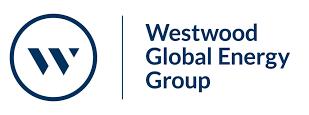
Westwood Global Energy Group are specialist providers of detailed market intelligence for the offshore energy sector, covering; offshore rigs, production facilities, subsea equipment, subsea services, offshore marine and offshore renewables and power.
www.westwoodenergy.com
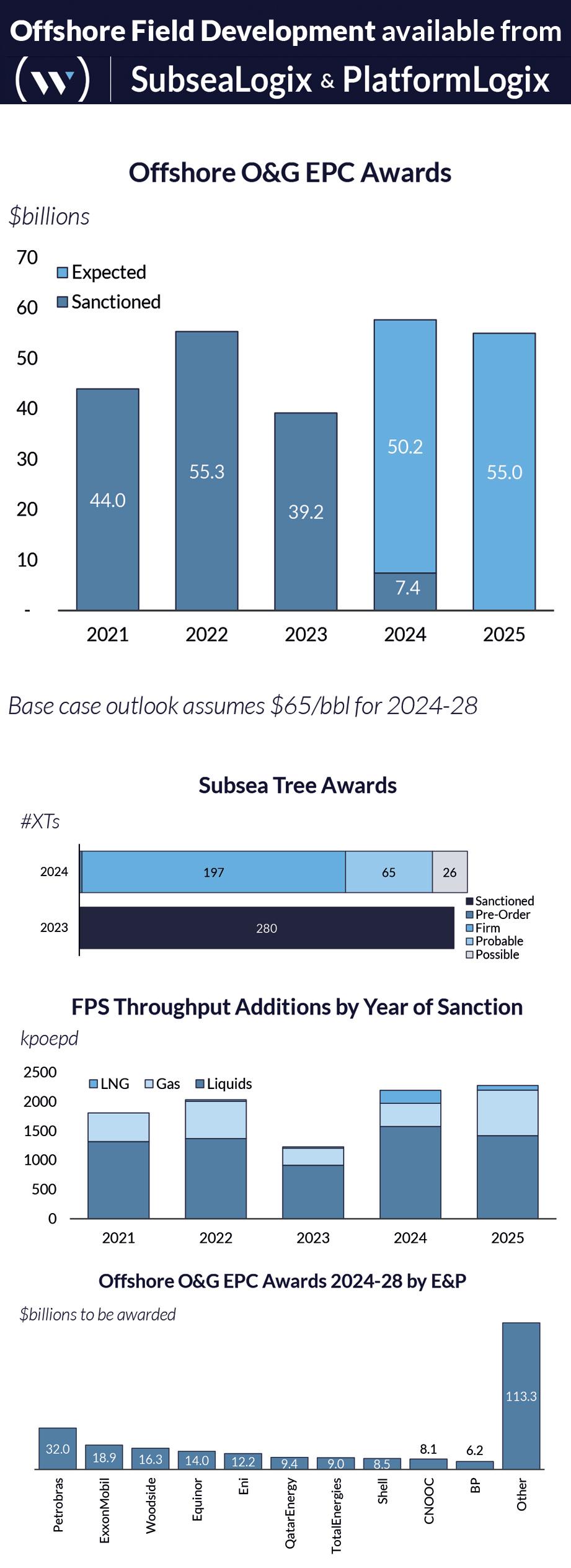
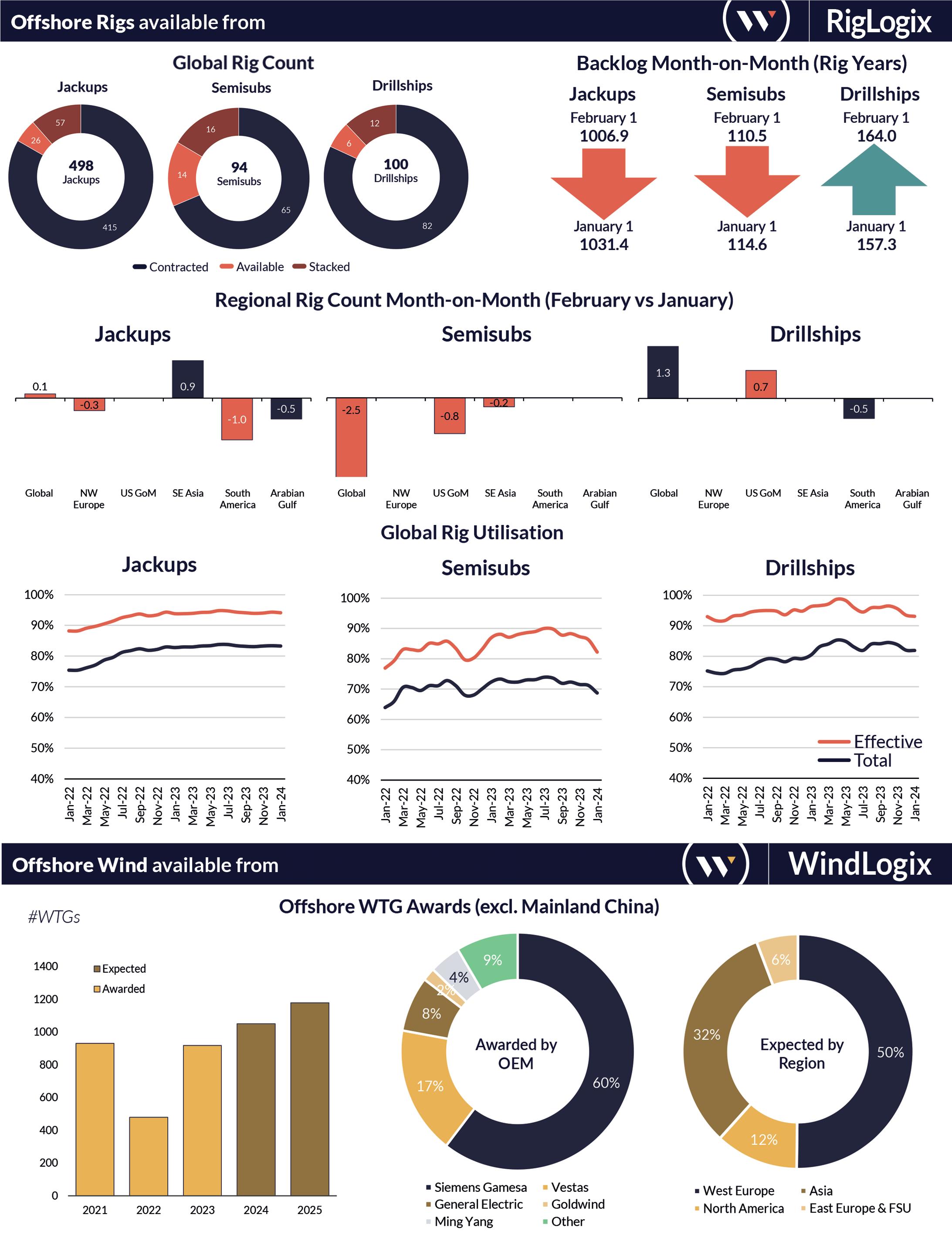


March


Oil & Gas World Expo
4-7 March 2024
Mumbai, India

Refining & Petro Chemicals
4-7 March 2024
Mumbai, India
Oil & Gas World Expo
4 March 2024
Mumbai, India
Smart Energy Conference & Exhibition
6-7 March 2024
Sydney, Australia
Australasian Oil and Gas
13 March 2024
Perth, Australia
Battery Tech Expo Central Europe
14 March 2024
Prague, Czech Republic
Digital Energy Expo
14 March 2024
Dubai, United Arab Emirates
CERAWeek 2024
18-22 March 2024
Houston, Texas, United States
Future of Utilities: Energy Transition Summit
20-24 March
Amsterdam, Netherlands
CING
25 March 2024
Beijing, China
CIPE
25 March 2024
Beijing, China
China International Shale Gas Tecnology
25 March 2024
Beijing, China
ICRESE-2024
25-27 March
Paris, France
Roseland West Texas Oil & Gas Convention
27 March 2024
Midland, USA


amongst the wider energy market and how the team can support companies with your most important asset, people.
Who are you and what is your role within ATPI?












In my position as Commercial Director for ATPI Australia I am responsible for the overall commercial success of the business. This includes leading the sales and account management team where I take an active role in building and maintaining strong customer relationship within the energy sector.
What do you think sets ATPI apart from other travel companies?
ATPI is a global leader, particularly in the energy sector. The team’s wealth of knowledge in the Australian market sets us apart from our competitors, and combined with the fact that we own and control all our own technology and operate one single platform globally make the offering to our customers truly unique. Whilst being a very strong global business, ATPI has maintained is ability to be agile and adapt to local inmarket changes swiftly.
Our dedicated team of experts in Australia provide consultancy and support to some of the world’s largest drilling and oilfield services companies. Each of our travel services and solutions have been created to meet the challenges presented by the energy industry, making your most important asset, people, the forefront of every travel policy.
What projects are you working on the support companies in the Energy sector?
Our projects are driven by industry trends and client demands. ATPI are members of several energy industry specific organisations around the world, this allows us to stay focused on what is important to the sector now, and in the future, to ensure that our proposition remains relevant.
We are seeing a significant focus across the energy sector on managing sustainable supply chains. ATPI Halo is our holistic solution for clients looking to address their travel-related sustainability targets, allowing clients to concentrate on their core business.
The ATPI Halo offering assists clients in measuring, reducing, and compensating their CO2e travel and events emissions. Clients globally have benefitted from our CO2e reporting and used ATPI Halo’s high quality, fully certified portfolio of carbon credit investment projects to offset all or part of their unavoidable travel CO2e footprint.
These carbon credits, support indigenous communities, protect wildlife, and proactively helping to remove carbon from the atmosphere. We review our projects regularly to ensure they continue to align with our clients’ sustainability goals.
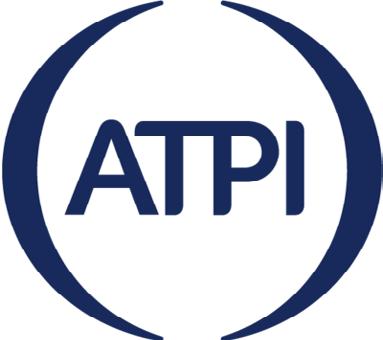
As the energy sector journeys towards more sustainable future, addressing the environmental impact of crew travel is paramount. ATPI Halo can help companies take a proactive step towards addressing environmental impacts.
What recommendations would you give companies to support the wellbeing of their employees when travelling for business?
ATPI prides itself on its long history of supporting the energy sector with duty of care solutions for travellers, in recent years we have witnessed an increased importance being placed on employee mental health and wellbeing that falls within the duty of c are scope.
Our recommendation is to partner with a specialist Travel Management Company (TMC) that understands the complexities of travel in the energy industry! Traveller wellbeing begins with having a robust travel policy and maintaining compliance across your programme. A specialist TMC is an extension of your team that not only provides travel expertise but understands your requirements, this is critically important when managing last minute or emergency travel requests.
Ensure you have access to the right tools and solutions. For example, traveller reporting should identify travel behaviours associated with wellbeing not only post-trip but also pre-trip providing the opportunity to take positive action prior to travel.
What are you looking forward to hearing about at AOG?
I am very much looking forward to hearing about how the industry is bridging the knowledge gap at present and in the future. With the energy industry facing human resources challenges, the generation who have evolved with the local market has started to reach retirement, the interest in joining the industry amongst the younger generation has started to dwindle. It will be great to see how other businesses are taking on this challenge.

Also, the Future Energy Forum, focussing on enhancing collaboration between operators, contractors, and the supply chain to drive a greater understanding of challenges and access to opportunities is also going to be a highlight of the conference.








